- Essay Topic Generator
- Summary Generator
- Thesis Maker Academic
- Sentence Rephraser
- Read My Paper
- Hypothesis Generator
- Cover Page Generator
- Text Compactor
- Essay Scrambler
- Essay Plagiarism Checker
- Hook Generator
- AI Writing Checker
- Notes Maker
- Overnight Essay Writing
- Topic Ideas
- Writing Tips
- Essay Writing (by Genre)
- Essay Writing (by Topic)

8th Grade Essay: Examples, Topics, & Writing Tips

If you find yourself on this page, you are probably going to another level of your education – the final year of Middle school!
Isn’t it exciting?
One of the most common assignments in the 8th grade is an essay. Indeed, it gains new features. An eighth-grade essay is not the same as the sixth or seventh-grade one. It has more requirements and needs a deeper level of analysis.
How to write an 8th-grade essay? How many paragraphs should it contain? What is a standard 8th-grade essay format? On this page, you’ll find the answers to these and other questions that might arise. We’ve prepared creative 8th-grade essay topics, examples, and tips to write an A+ informative, narrative, or persuasive essay.
- 🧩 8th Grade Essay 101
- 📑 8th-Grade Essay Types
- 💾 Topics for the 8 th -Graders
🍎 8th Grade Essay Examples
🧩 8th-grade essay format explained.
Once again: the 8th-grade essay format is a bit different from that of the previous years.
Below, we thoroughly explain how long an 8th-grade essay should be and how to write it. We guarantee you’ll have no questions about the format and assessment of this type of work.
What Is the 8 th Grade Essay Format?
In this section, you’ll know which parts comprise any 8th-grade essay.
The first thing to remember: you’ve got onto an entirely new level. So, your writing isn’t as simple and short as it used to be in the previous school years.
Let’s start with the structure. The fundamental parts are the same as in any type of essay:

8th Grade Essay: How to Write & Typical Mistakes
With the help of this section, you’ll get to know the most straightforward and helpful tips for 8th-grade essay writing.
These are the things that any 8th grader should know!
8 th Grade Essay Do’s
- Look for reliable sources to find arguments and evidence.
- Try to arouse eagerness for writing: it surely will ease the whole process for you.
- Choose the topic that is interesting for you if you have such an option.
- Use academic language, special terms, consistent phrases, and correct grammar.
- Use good quotations from reputable sources to solidify your ideas.
8 th Grade Essay Don’ts
- Don’t write dully: an essay is a story. It should be exciting and consistent.
- Don’t make all your examples too similar: diversity is of the essence.
- Don’t let your text look like an unreadable pile of words: use graphic tools to highlight the most critical points.
- Don’t use unreliable sources and websites for citation.
- Don’t be afraid of honest self-expression. Your identity and thoughts are what make your 8th-grade essay unique.
- Don’t forget to revise your text after you’ve finished writing it.
8th Grade Essay Rubric
Meet the assessment strategies for 8th-grade writing. Here you’ll also find some prompts that improve your essay and lead you to a higher score.
So, the assessment pattern of a written piece comprises several main points. These are the things that assessors pay attention to:
📑 Eighth Grade Essay Types
We suppose that you come across different types of assignments during middle school. Among them, there indeed were descriptive and narrative essays.
However, now you are to face other exciting formats of writing. In the section below, you’ll get to know a few new types.
8th Grade Argumentative Essay
An argumentative essay is a piece of writing where you make a claim and prove your point of view with solid arguments. Your aim at this point is to make readers nod in contempt while reading and share your opinion.
The structure may be pretty familiar to you:
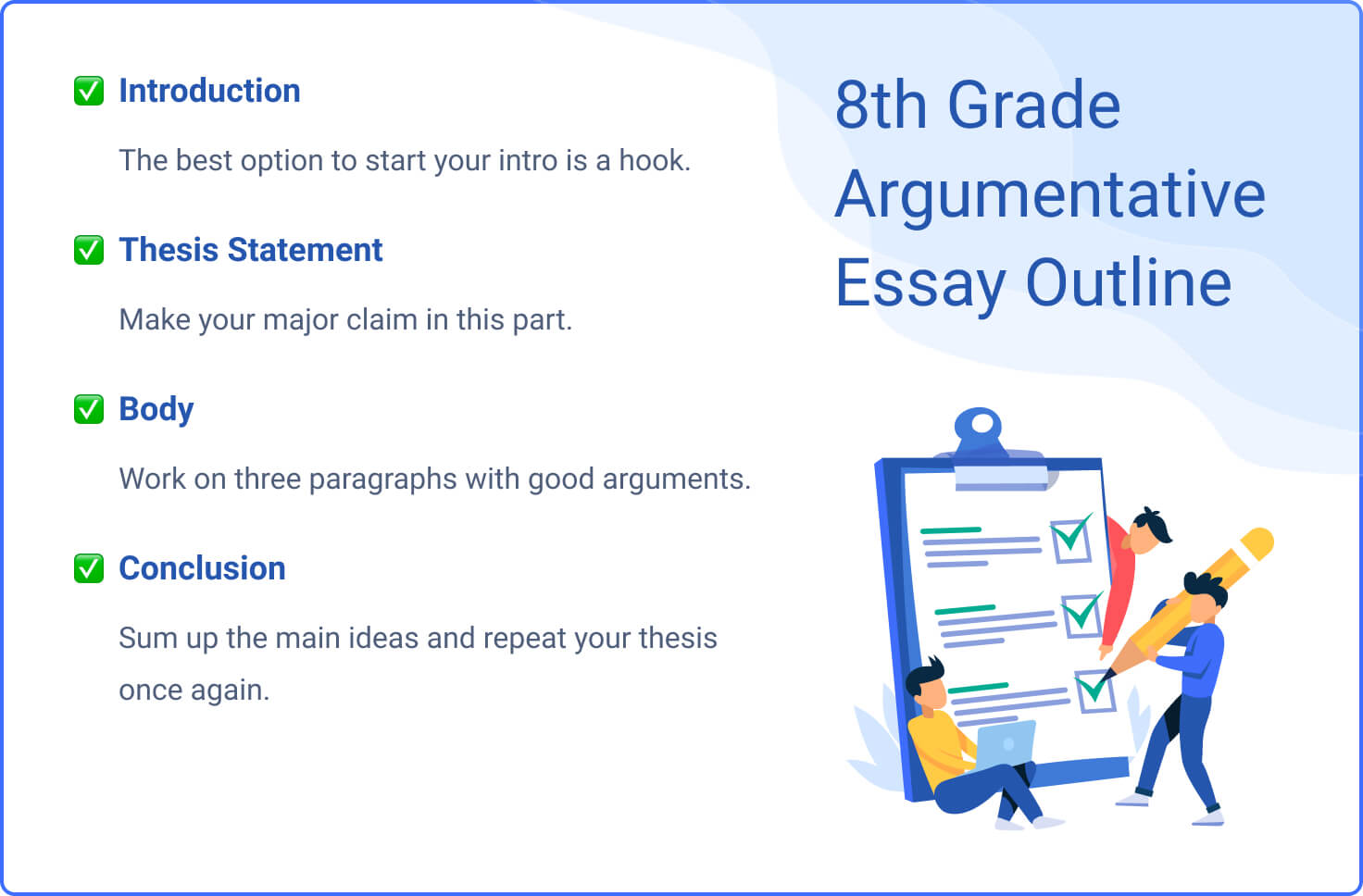
In your argumentative essay, you should back up your opinion with some exact data: statistics, figures, research studies, and polls.
To solidify your claim, you can use three types of arguments:
- Aristotelian . The classical way – you make a statement and try to persuade the audience that it is the one that is fair and right.
- Rogerian . First, you display an issue, then present the opposing view. After that, reveal your own opinion and start convincing readers why they should take up your point.
- Toulmin . Present your thesis statement, then provide the audience with the grounds to support it. The final touch is to connect these parts.
PRO TIP: Explain why you disagree with the opposing point of view on your issue.
8th Grade Persuasive Essay
A persuasive essay is very similar to argumentative writing. There you have to pick up a mainly burning issue and establish a firm opinion towards it. The primary goal is the same as in the argumentative essay: to make your readers believe you.

Remember the three essentials of persuasive writing:
- Logos appeals to logic, which is apparent. Deliver your thoughts cohesively and reasonably.
- Ethos is about persuading the readers, appealing to their sense of ethics and morality.
- Pathos helps you convince through emotions.
8th Grade Essay – Informative
An expository essay brings concepts to complete understanding. In other words, you explain something to give a clue about the subject in question. Successful expository writing makes the audience get the whole picture, leaving no questions or misunderstandings.
To familiarize yourself with expository essay structure, check our recently updated guide on writing an expository essay .
And briefly look at six major types of expository essays:
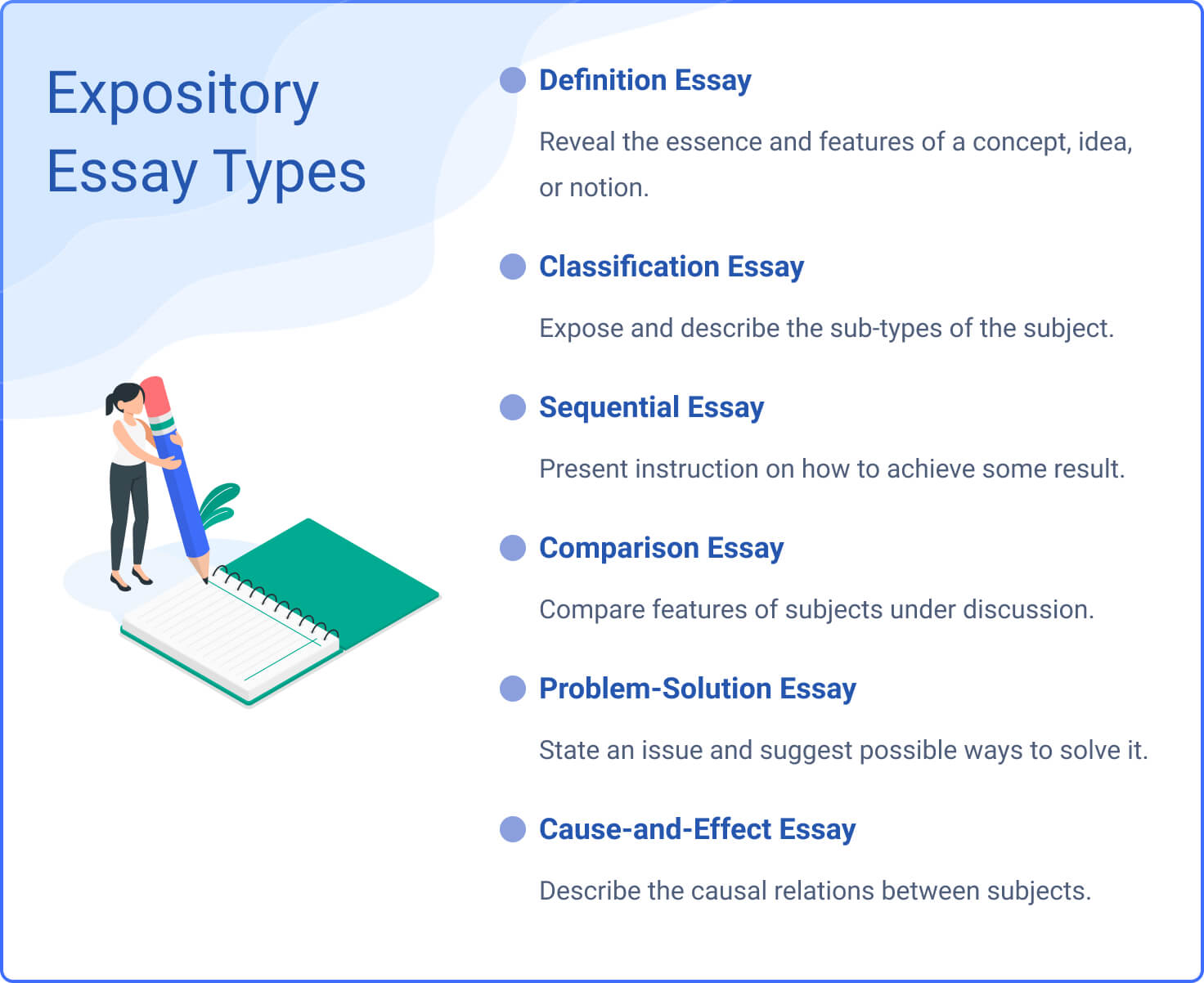
💾 8th Grade Essay Topics
8th grade argumentative essay topics.
- What is the main challenge you’ve ever met?
- What was the happiest moment of your childhood?
- Tell about the accomplishment you’re most proud of.
- What are the personal qualities you like most?
- Write about an inspiring celebrity.
- What does emotional intelligence mean?
- Write about the largest challenge of getting older.
- How is adolescence different from childhood?
Read the list of topics we’ve prepared for an 8th-grade essay. Choose your favorite or use our Free Essay Topics Generator to find the best one.
Persuasive Essay Topics for 8th Grade
- Would limited screen time be beneficial for health?
- Will the global use of electric vehicles save us from the ecological crisis?
- The government should provide citizens with more qualified psychological help.
- What are the pros and cons of buying a pet for a child?
- Should people use paper and textile bags instead of plastic ones?
- Is it necessary to attend PE classes in school?
- Is it ethical to use smartphones during the lesson?
- Should parents forbid their children from watching TikTok?
- Pros and cons of cheating on exams: immoral or beneficial?
- Should there be only healthy snack vending machines at schools?
- Is it acceptable for a teacher to raise the voice at a student?
- Should modern rappers’ songs be put through censorship?
- Is it ethical for students to discuss their teachers?
- Should all cosmetic products become cruelty-free?
- Should we stop the overconsumption of sugar for the sake of our health?
- Should zoos and circuses be banned forever?
8th Grade Informative Essay Topics
- Compare and contrast the environmental policies of the USA and Europe.
- What are the harmful effects of CO 2 emissions on the environment?
- How is the concept of freedom reflected in 20th-century literature?
- Reveal the details of the famous friendship of Hemingway and Fitzgerald.
- Brush off or fight: how to act when you come across bullying at school?
- What are the most significant challenges school attendees usually face?
- How to overcome your fears without getting traumatized?
- How to prepare for the exam period and overcome anxiety?
- Freedom or despair: the history and concept of trailer parks in the USA.
- Explain the concept of sustainability and what benefits it has.
- Provide a classification of American lifestyles based on location.
- A reasonable person: describe the concept and the features.
Look at our 8th grade essay examples. These are mostly just excerpts, but we included the most significant parts. Approach us in case you need a similar paper or have any questions.
8th Grade Argumentative Essay Example (#1)
The most notorious substance in the ecological discourse: is CO 2 really that bad?
Did you know that it’s better for the earth if you work out or jog with your mouth tightly shut? It’s not common knowledge, but professionals know: we need a considerable amount of CO 2 in our blood. In some terms, it’s even more vital than oxygen. Undoubtedly, there has to be a proper balance, and here is the point: CO 2 can be beneficial.
Though what good does it make to nature and the environment?
It’s all the same as with our body: CO 2 is not evil on earth, but there must be a proper balance. Now, this balance is critical, and we must make serious efforts to change the situation.
- According to last year’s research, the USA is in the second place among countries producing the most significant part of CO 2 in the whole world. The website statista.com published striking figures. 4.57 million metric tons of carbon dioxide emissions were produced in 2020 by the energy consumption sphere in the United States.
- Besides, a recently published report from the IEA agency reveals another piece of statistics. Compared to the previous year, the amount of CO 2 emissions will rise to 5% in 2021. This year we’re facing 33 billion tons of this greenhouse gas.
- These figures mean nothing without context. Here you are: nature suffers greatly from CO 2 influence. Due to the greenhouse effect caused by an excess of CO 2 , the water temperature in oceans and seas is rising. This process is not positive at all because the natural habitat for sea creatures is altering. The changes are dramatic and lead to the extinction of many species.
In conclusion, we need to find an efficient way to improve the ecological situation regarding CO 2 emissions. The key is global social and individual awareness and consciousness. Each and every inhabitant of the Earth has to understand the meaning of CO 2 for global warming clearly. So, try to jog with your lips closed and choose a bike instead of a car.
Example #2: 8th Grade Persuasive Essay
Is it essential to stay away from social media for the sake of mental health?
Nielsen Company conducted research that says that the average US adult spends more than 10 hours interacting with social media each day. Indeed, social media plays a very considerable role in the life of a modern person. Most of us are more likely to spend time watching short videos than reading a good book. But is it harmful to our mental health to the extent that we have to quit using social media platforms?
To my mind, we are greatly dependent on our Instagram and TikTok accounts, and the content posted there. It certainly has a negative impact, too. However, the complete cancellation of social media is not a way out. The key to good mental condition is in the skill of managing your relations with them.
- One of the recent surveys by the Lancet reports that Facebook users who scroll the newsfeed before sleep tend to be more depressed. Apparently, the deprivation of sleep affects mental well-being to a great extent.
- FInancesOnline has recently posted the results of the research. According to this data, Facebook constitutes 72% of people’s FOMO and anxiety. Posts about traveling and active social life create most of these feelings.
- At the same time, healthy rivalry can motivate development and growth. There’s a reasonable quotation saying that one should compare themselves yesterday instead of comparing to others. The best thing one can do to take care of their mental health is to take a digital detox for a while.
Thus, it is vital to trace your obsessions with social media and negative feelings caused by comparison with others on the Internet. Try to get more aware of it, take your time to rest from social media, and plunge into real life.
5 Paragraph Essay Example for 8th Grade (#3)
The Financier and American Tragedy : compare and contrast two main characters of Dreiser’s novels.
Do you know that Theodore Dreiser is sometimes called an American Fyodor Dostoevsky? Both writers touched upon the most sensitive social and existential issues. However, the subject of this paper is not the comparison of the authors but two famous Dreiser characters: Clyde Griffiths and Frank Cowperwood.
Both of these young American men were striving to reach financial and social success in a world of brutal struggle and hardships.
- Clyde Griffiths represents the desperate strive for American Dream. Born in a poor and religious family, he grows greedy for money and status. In his blind obsession with gaining a high social position, he doesn’t notice his spiritual degradation. He is smart enough to struggle his way into high society but not so witty to solidify his standing with decent means. He cheats, lies, and finally commits a murder: Clyde seems to be already born guilty at times. On reading the story, there doesn’t appear any sympathy toward him. On the contrary, he provokes feelings of abomination and disgust.
- Frank Cowperwood also aims to become wealthy and socially firm. He wants to improve his family’s life quality. Still, his ways and means astonish. Frank is a natural-born predator and strategist. His sophistication and sharp wit show up in him since his very childhood. He isn’t a man of high moral standards: Frank doesn’t mind cheating on his wife and manipulating city treasure money. However, he’s a passionate man, honest and open in his heart urges and impulses. That is the reason why fortune favors him.
However, having similar goals but different personalities and mindsets, Griffiths and Cowperwood reach completely different destination points.
How to Write an Essay in 8th Grade?
– You should pick up a good topic and formulate your attitude to the problem. – Write an outline. – Make a clear and brief thesis statement. – Think of at least 3 firm arguments if the essay type demands it. – Impress your readers with a firm conclusion. Voila! Do not forget to proofread!
How Long Is an Essay in 8th Grade?
The length of the 8th-grade essay slightly depends on the format and the particular type of writing. However, it varies from approximately 500 to 800 words. Within this framework, you have to make yourself clear and deliver all necessary points.
How Many Sentences Are in a Paragraph for 8th Grade?
The size of a paragraph in the 8th-grade essay has to be not less than 8 sentences in each. Besides that, mind that the sentences are primarily compound or complex, error-free, and coherent. Also, remember to connect the sentences and paragraphs with particular language means.
How to Write an Argumentative Essay in 8th Grade?
Choose an exciting and acute topic. Make up a thesis statement out of the problem. Draft an outline or a brief plan. Explore some reliable sources for the evidence and arguments for your essay. Organize the facts and information into a cohesive structure.
I’m an 8th grade student at a private school, and my teacher assigns us up to 4-6 pages most to write. First of all we get other essays on top of this, and usually have nearly to a week to finish. Me and my classmates struggle with this. Do you guys think this is too much for an average 8th grade student?
i am writin apaper right now and it is averreding and its about the changes we woud make to our cafeteria it has to be 5 paragraphs long
Thanks for stopping by at our blog. We would be happy to help you with your paper. You can be interested in some other posts on this blog (https://overnightessay.com/blog/category/essay-tips/) or contact our friendly Support Team to get professional writign help from experienced writers. Good luck with your paper! Best regards,
Have a language expert improve your writing
Run a free plagiarism check in 10 minutes, generate accurate citations for free.
- Knowledge Base
- How to conclude an essay | Interactive example
How to Conclude an Essay | Interactive Example
Published on January 24, 2019 by Shona McCombes . Revised on July 23, 2023.
The conclusion is the final paragraph of your essay . A strong conclusion aims to:
- Tie together the essay’s main points
- Show why your argument matters
- Leave the reader with a strong impression
Your conclusion should give a sense of closure and completion to your argument, but also show what new questions or possibilities it has opened up.
This conclusion is taken from our annotated essay example , which discusses the history of the Braille system. Hover over each part to see why it’s effective.
Braille paved the way for dramatic cultural changes in the way blind people were treated and the opportunities available to them. Louis Braille’s innovation was to reimagine existing reading systems from a blind perspective, and the success of this invention required sighted teachers to adapt to their students’ reality instead of the other way around. In this sense, Braille helped drive broader social changes in the status of blindness. New accessibility tools provide practical advantages to those who need them, but they can also change the perspectives and attitudes of those who do not.
Instantly correct all language mistakes in your text
Upload your document to correct all your mistakes in minutes

Table of contents
Step 1: return to your thesis, step 2: review your main points, step 3: show why it matters, what shouldn’t go in the conclusion, more examples of essay conclusions, other interesting articles, frequently asked questions about writing an essay conclusion.
To begin your conclusion, signal that the essay is coming to an end by returning to your overall argument.
Don’t just repeat your thesis statement —instead, try to rephrase your argument in a way that shows how it has been developed since the introduction.
Prevent plagiarism. Run a free check.
Next, remind the reader of the main points that you used to support your argument.
Avoid simply summarizing each paragraph or repeating each point in order; try to bring your points together in a way that makes the connections between them clear. The conclusion is your final chance to show how all the paragraphs of your essay add up to a coherent whole.
To wrap up your conclusion, zoom out to a broader view of the topic and consider the implications of your argument. For example:
- Does it contribute a new understanding of your topic?
- Does it raise new questions for future study?
- Does it lead to practical suggestions or predictions?
- Can it be applied to different contexts?
- Can it be connected to a broader debate or theme?
Whatever your essay is about, the conclusion should aim to emphasize the significance of your argument, whether that’s within your academic subject or in the wider world.
Try to end with a strong, decisive sentence, leaving the reader with a lingering sense of interest in your topic.
The easiest way to improve your conclusion is to eliminate these common mistakes.
Don’t include new evidence
Any evidence or analysis that is essential to supporting your thesis statement should appear in the main body of the essay.
The conclusion might include minor pieces of new information—for example, a sentence or two discussing broader implications, or a quotation that nicely summarizes your central point. But it shouldn’t introduce any major new sources or ideas that need further explanation to understand.
Don’t use “concluding phrases”
Avoid using obvious stock phrases to tell the reader what you’re doing:
- “In conclusion…”
- “To sum up…”
These phrases aren’t forbidden, but they can make your writing sound weak. By returning to your main argument, it will quickly become clear that you are concluding the essay—you shouldn’t have to spell it out.
Don’t undermine your argument
Avoid using apologetic phrases that sound uncertain or confused:
- “This is just one approach among many.”
- “There are good arguments on both sides of this issue.”
- “There is no clear answer to this problem.”
Even if your essay has explored different points of view, your own position should be clear. There may be many possible approaches to the topic, but you want to leave the reader convinced that yours is the best one!
Here's why students love Scribbr's proofreading services
Discover proofreading & editing
- Argumentative
- Literary analysis
This conclusion is taken from an argumentative essay about the internet’s impact on education. It acknowledges the opposing arguments while taking a clear, decisive position.
The internet has had a major positive impact on the world of education; occasional pitfalls aside, its value is evident in numerous applications. The future of teaching lies in the possibilities the internet opens up for communication, research, and interactivity. As the popularity of distance learning shows, students value the flexibility and accessibility offered by digital education, and educators should fully embrace these advantages. The internet’s dangers, real and imaginary, have been documented exhaustively by skeptics, but the internet is here to stay; it is time to focus seriously on its potential for good.
This conclusion is taken from a short expository essay that explains the invention of the printing press and its effects on European society. It focuses on giving a clear, concise overview of what was covered in the essay.
The invention of the printing press was important not only in terms of its immediate cultural and economic effects, but also in terms of its major impact on politics and religion across Europe. In the century following the invention of the printing press, the relatively stationary intellectual atmosphere of the Middle Ages gave way to the social upheavals of the Reformation and the Renaissance. A single technological innovation had contributed to the total reshaping of the continent.
This conclusion is taken from a literary analysis essay about Mary Shelley’s Frankenstein . It summarizes what the essay’s analysis achieved and emphasizes its originality.
By tracing the depiction of Frankenstein through the novel’s three volumes, I have demonstrated how the narrative structure shifts our perception of the character. While the Frankenstein of the first volume is depicted as having innocent intentions, the second and third volumes—first in the creature’s accusatory voice, and then in his own voice—increasingly undermine him, causing him to appear alternately ridiculous and vindictive. Far from the one-dimensional villain he is often taken to be, the character of Frankenstein is compelling because of the dynamic narrative frame in which he is placed. In this frame, Frankenstein’s narrative self-presentation responds to the images of him we see from others’ perspectives. This conclusion sheds new light on the novel, foregrounding Shelley’s unique layering of narrative perspectives and its importance for the depiction of character.
If you want to know more about AI tools , college essays , or fallacies make sure to check out some of our other articles with explanations and examples or go directly to our tools!
- Ad hominem fallacy
- Post hoc fallacy
- Appeal to authority fallacy
- False cause fallacy
- Sunk cost fallacy
College essays
- Choosing Essay Topic
- Write a College Essay
- Write a Diversity Essay
- College Essay Format & Structure
- Comparing and Contrasting in an Essay
(AI) Tools
- Grammar Checker
- Paraphrasing Tool
- Text Summarizer
- AI Detector
- Plagiarism Checker
- Citation Generator
Your essay’s conclusion should contain:
- A rephrased version of your overall thesis
- A brief review of the key points you made in the main body
- An indication of why your argument matters
The conclusion may also reflect on the broader implications of your argument, showing how your ideas could applied to other contexts or debates.
For a stronger conclusion paragraph, avoid including:
- Important evidence or analysis that wasn’t mentioned in the main body
- Generic concluding phrases (e.g. “In conclusion…”)
- Weak statements that undermine your argument (e.g. “There are good points on both sides of this issue.”)
Your conclusion should leave the reader with a strong, decisive impression of your work.
The conclusion paragraph of an essay is usually shorter than the introduction . As a rule, it shouldn’t take up more than 10–15% of the text.
Cite this Scribbr article
If you want to cite this source, you can copy and paste the citation or click the “Cite this Scribbr article” button to automatically add the citation to our free Citation Generator.
McCombes, S. (2023, July 23). How to Conclude an Essay | Interactive Example. Scribbr. Retrieved April 1, 2024, from https://www.scribbr.com/academic-essay/conclusion/
Is this article helpful?
Shona McCombes
Other students also liked, how to write an essay introduction | 4 steps & examples, how to write a thesis statement | 4 steps & examples, example of a great essay | explanations, tips & tricks, "i thought ai proofreading was useless but..".
I've been using Scribbr for years now and I know it's a service that won't disappoint. It does a good job spotting mistakes”
Reading Worksheets, Spelling, Grammar, Comprehension, Lesson Plans
How to Write a Conclusion Paragraph
Conclusion paragraphs can be tricky to write, but a clear conclusion can sum up your main points and leave your reader with a clear sense of what to take away from your overall essay. Creating a strong essay means making sure that you have a clear introduction , several body paragraphs, and knowing how to write a conclusion paragraph. Keep reading closely, and you’ll know how to write a conclusion paragraph. Read on for a step-by-step guide on how to write a conclusion paragraph, and then check out our library of conclusion worksheets to get plenty of practice in how to write a conclusion paragraph.
Choose Smooth Conclusion Transition Words
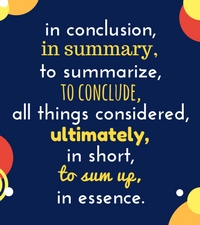
Restate Main Points
Another key aspects of how to write a conclusion paragraph is that you signal that you are drawing your essay to a close, so that you can then restate the main points of your essay. Depending on the length of your essay, this may be done in a single sentence, or it may require a few sentences. Be concise and clear; you should be able to summarize each main point in a simple phrase that avoids restating each detail and piece of evidence related to the point. Simply list off the points as a reminder to your audience about what they’ve just read.
Restate Your Argument
Finally, if you’re writing an argumentative essay, a key component of how to write a conclusion paragraph is that you’ll want to clearly restate your main argument in order to leave readers with one final appeal. If you have provided enough evidence along the way, this restatement should make readers feel as if you’ve persuaded them fully.
Call to Action
For some expository and argumentative essays, a key part of how to write a conclusion paragraph involves a call to action as your last sentence. For example, if you’re writing an informative essay about the sea creatures that live in the very deepest parts of the ocean, you may close with a sentence like this: “It’s clear that today’s scientists should continue to observe and document these mysterious creatures, so we may all learn more about life at the bottom of the ocean.” A call to action like this can make your reader feel inspired and informed after reading your essay.
What to Avoid with Conclusion Transitions
When determining how to write a conclusion paragraph, you want to keep it simple. Use a clear transition word or phrase, restate your main points and argument, and possibly finish with a call to action. Be sure to avoid the following missteps:
- New Information . Your conclusion is not the place to introduce anything new. Simply restate and summarize the main points clearly.
- Personal Opinion . Unless you are writing an opinion piece that includes several “I” statements throughout, avoid ending your essay with a sudden “I think…” or “I feel…” If you haven’t been including your personal opinion throughout the essay, then you shouldn’t insert your opinion into the conclusion.
- Lots of Details . When you restate your main points, don’t worry about restating all the small details that make up your description or evidence. The place for details is in your body paragraphs. The conclusion is simply for summary and a possible call for action or next steps.
Check out our printable conclusion paragraph worksheets too!

How to write a Conclusion
What is a Conclusion?

Before we learn how to write a conclusion, we need to determine what a conclusion is.
A conclusion is the final sentences or paragraph in a piece of writing that signifies the end of a text, event or process.
We can find conclusions everywhere, from narratives, letters and reports to persuasive essays and speeches.
Conclusions perform many functions, which we will examine throughout this article. Fundamentally, they wrap everything up and finish a piece of writing or a presentation.
Unfortunately, conclusions are often the most challenging section of a paper to write. They are the final words of the writer on the topic and, as a result, play a crucial part in the lasting impression the writing leaves on the reader.
For this reason, our students must take time to understand clearly the functions of a conclusion and how they work. Time spent mastering the art of conclusion writing will be time well spent.
A COMPLETE UNIT ON HOW TO WRITE A CONCLUSION
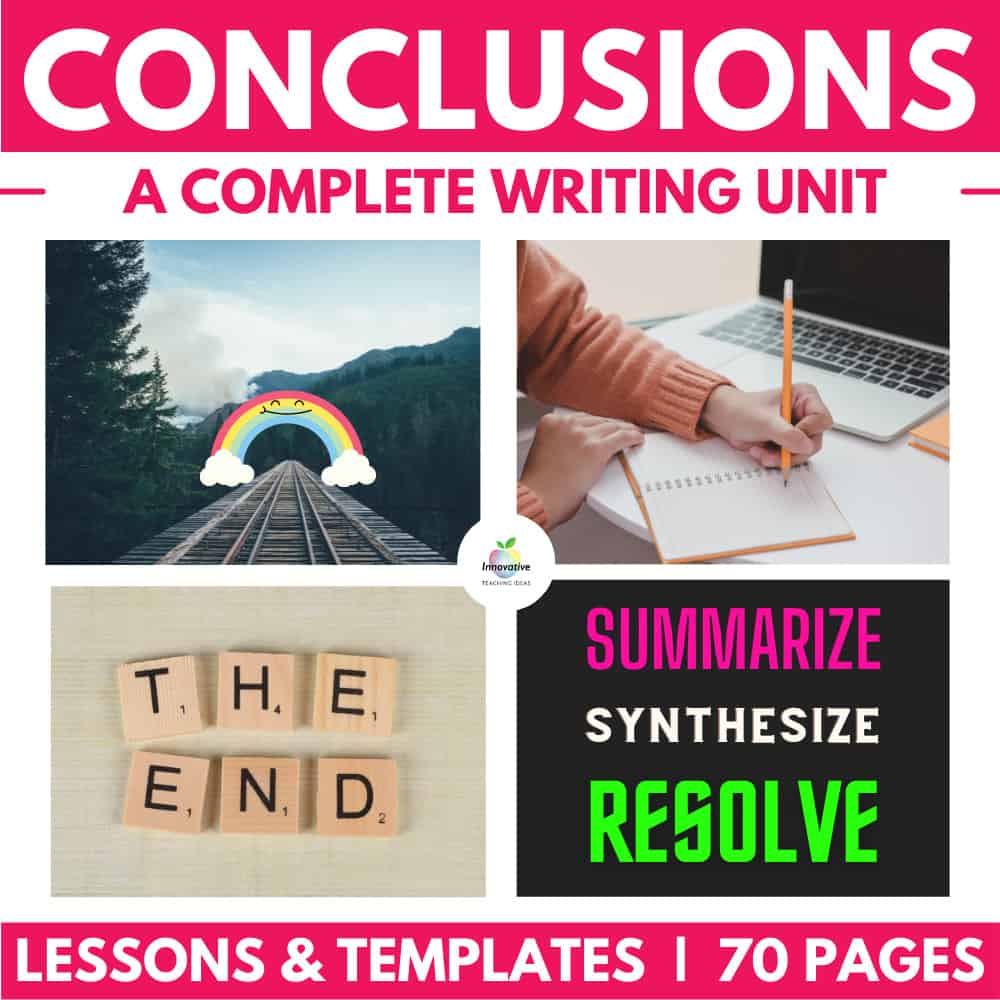
Teach your students to write POWERFUL CONCLUSIONS that put a bow on a great piece of writing. All too often, students struggle to conclude their writing. Stumbling, repeating themselves, or missing the opportunity to make a lasting impression.
This COMPLETE UNIT OF WORK will take your students from zero to hero over FIVE STRATEGIC LESSONS covered.
What is the Purpose of a Concluding Paragraph

Unfortunately, there is no one-size-fits-all formula we can teach our students that they can use to write any conclusion. Conclusions perform several functions, varying widely from paper to paper. Some of these functions include:
- Restates a paper’s thesis and explains why it’s important
- Synthesizes the essay’s arguments
- It opens up new questions
- Addresses limitations
- Makes a call to action.
Not all conclusions will perform each of these functions. How our students approach writing their conclusions will depend on several factors, including:
- The conventions of the writing genre
- The intended audience and their motivations
- The formality or informality of the paper
- The tone of the writing.
Now, let’s look at each of the functions of a conclusion one by one, along with a practice activity for each to give our students some hands-on practice.
1. A Concluding Paragraph Restates the Thesis and Explains Why
One of the most common errors in writing a conclusion is to use it to simply restate the thesis. Though this is widely taught, it isn’t enough.
The student should also explain why the argument made in their thesis is important. This involves considering the more widespread impact of the thesis and its supporting arguments.
The conclusion should inform the reader why the thesis matters by answering questions similar to the following:
- What are the wider societal implications of the thesis?
- Does the thesis challenge a widely accepted idea or belief?
- Does the thesis have significance for how things could be done in the future?
To write a conclusion in this vein, it is helpful for students to compose similar type questions relevant to their thesis, which they can then set out to answer.
These questions will vary widely according to the subject being written about and the genre being written in. Still, regardless, the conclusion should highlight the thesis’s significance to the wider world. This will bring context to the writing as a whole.
Example: In conclusion, this paper has argued that increasing access to education is essential for reducing poverty and promoting economic development. We have presented evidence from various studies showing the positive correlation between education and income and the role of education in fostering other developmental goals, such as improved health and reduced inequality. Restating the thesis, we can say that access to education is a fundamental human right and should be prioritized as a key development strategy to reduce poverty and promote sustainable economic growth. The evidence presented in this paper supports this argument, making a case for the importance of increasing access to education for the well-being of individuals and societies.
2. A CONCLUSION SYNTHESIZES THE PAPER’S ARGUMENTS
This is another very common function performed by the conclusion. While each body paragraph in the paper may correspond to a single specific argument in support of the central thesis, in the conclusion, the various strands of supporting arguments are woven into a coherent whole.
The conclusion is not the place to introduce new arguments or to simply list the arguments made in the body paragraphs. Instead, it provides a final opportunity for your students to drive home their main arguments one last time and make connections between them to reveal a coherent whole.
Often, a conclusion will combine functions of functions 1 and 2 by restating the thesis, synthesizing the arguments, and explaining the wider significance of the thesis.
When considering how to write a conclusion for an argumentative essay, remember to synthesize it.
Example: In conclusion, this paper has presented a thorough examination of the current state of renewable energy sources and their potential to combat climate change. Through an analysis of the economic and technical feasibility of various renewable energy options, we have shown that renewable energy is a viable and necessary solution to reducing carbon emissions. Additionally, we have highlighted the importance of government policies and investment in research and development to accelerate the adoption of renewable energy. Overall, this paper argues that renewable energy is a crucial step in the fight against climate change and must be prioritized to secure a sustainable future.
3. A CONCLUSION CAN OPEN UP NEW QUESTIONS
We often think of conclusions as drawing things to a close. But there’s another way of looking at things. Often, through the process of making various arguments in a piece of writing, new questions will emerge naturally.
This method is commonly encountered when exploring how to write a conclusion for a thesis.
This often occurs when the central thesis is set in a broader context. We can think of the progression of an essay as moving from a thesis statement through evermore specific arguments that support that initial thesis statement.
To open up new questions in the conclusion, the student should move from the specific to the more general, generating further possible lines of inquiry on the topic as they go. The effect of this type of conclusion is to spark the reader’s curiosity and further interest in the subject.
Example: In conclusion, our research has provided an in-depth examination of the effects of climate change on biodiversity. Our findings indicate that climate change is having a significant impact on the distribution and abundance of species. However, our research has also revealed that there are still many unanswered questions about the mechanisms driving these changes. For example, more research is needed to understand the role of different species interactions and the effects of climate change on specific ecosystem functions. We hope our research will serve as a foundation for further studies and inspire other researchers to continue investigating the complex relationship between climate change and biodiversity.
4. A CONCLUSION PARAGRAPH ADDRESSES THE LIMITATIONS
This method is often used in academic or scientific writing when considering how to write a conclusion for a report. In it, the student writer directly explores the weaknesses of their arguments.
It’s perhaps the bravest type of conclusion there is! Students need to be careful not to destroy their own thesis in the process. A sentence mentioning the limitation, quickly followed by a sentence or two addressing the problem, should be enough.
When done well, this strategy strengthens the impact of a paper by dealing head-on with potential criticisms and making strong counter-arguments in the process.
Example: In conclusion, our research provides valuable insights into the relationship between environmental factors and academic performance. However, it is important to note that our study has limitations. Firstly, the sample size was relatively small, and our results may not be generalizable to a larger population. Additionally, our study only considered one specific type of environmental factor and did not take into account other factors that may impact academic performance. Despite these limitations, our research provides a starting point for future studies in this area.
5. A CONCLUSION CAN OFFER A CALL TO ACTION

In a call-to-action type conclusion, the writer compels the reader to take a desired action or perform a particular task. This type of conclusion aims to persuade the reader or listener to do something.
Call-to-action conclusions work in various genres, including presentations, speeches, advertisements, and persuasive essays .
There are various techniques students can use to inspire action in their conclusions, such as appeals to emotions, the use of strong imperatives, or appeals to the reader’s or the listener’s self-interest.
Example: In conclusion, our research highlights the importance of access to clean drinking water in developing countries. Our findings show that a lack of access to clean water can lead to serious health issues and negatively impact the economy. However, it is not enough to simply acknowledge this problem – action must be taken. We call on governments, non-profit organizations, and individuals to take action by investing in infrastructure and providing education on sanitation and hygiene. Together, we can work towards providing access to clean water for all, and, ultimately, improve the quality of life for people living in developing countries.
Tips for Writing a Strong Conclusion
As young writers, crafting a solid conclusion for your essay is essential to communicate your ideas effectively. A well-written conclusion can help to summarize your main points, provide closure to your argument, and leave a lasting impression on your reader. Here are ten tips for writing a strong conclusion to an essay for high school students:
- Restate the main idea of your essay. A good conclusion should summarize the main points of your essay and reiterate the main idea or thesis statement.
- Provide closure to your argument. Your conclusion should provide a sense of closure to your argument and tie up any loose ends.
- Emphasize the importance of your topic. Your conclusion should also emphasize the importance of the topic you have discussed and why it matters to your reader.
- Offer a call to action. Encourage your reader to take action or think more deeply about the issues you have discussed in your essay.
- Avoid introducing new information. Your conclusion should be a summary of your main points, not a place to introduce new information or ideas.
- Keep it simple. Avoid using complex phrases or convoluted language in your conclusion.
- Use a strong concluding sentence. Your last sentence should be a powerful statement that leaves a lasting impression on your reader.
- Avoid summarizing every point. You don’t have to summarize every point you made in the essay; pick the main and most important ones.
- Reflect on your essay’s meaning. Take a step back and reflect on the overall meaning of your essay and the message you want to convey to your reader.
- Revise and proofread . Revise and proofread your conclusion carefully to ensure it is clear, concise, and error-free.
By following these tips, you can write a strong conclusion that effectively communicates your ideas and leaves a lasting impression on your reader.
What shouldn’t a conclusion do?
So far, we’ve discussed some conclusion writing strategies by discussing things a good conclusion should do. Now, it’s time to look at some things a conclusion shouldn’t do.
The following list contains some of the most common mistakes students must avoid making in their conclusions. This list can help students troubleshoot their conclusions when they get stuck or run into problems.
1. Uses a Vague Thesis Statement
If the student struggles to make a powerful impact in their conclusion, it may be because their thesis statement is too vague.
If this is the case, they messed up long ago.
The first time the reader sees the thesis statement should be in the introduction. Because all arguments stem from that statement, a comprehensive rewrite of the entire paper will most likely be needed.
2. Opens with a Clichéd Phrase
When students begin to learn to write conclusions, they often learn some stock phrases to help kickstart their writing. Phrases such as ‘in conclusion’ or ‘to conclude’ can be useful as prompts to get students quickly into the meat of their writing. However, overuse of such stock phrases can leave the writing feeling mechanical.
Ultimately, we want more for our students. If one of the purposes of a conclusion is to make a powerful impact on the reader, we must encourage our students to be creative and bold in their writing.
3. Doubts the Thesis
In the first part of this article, we briefly discussed the idea of addressing the limitations of the thesis and supporting arguments. This can be an effective strategy for students, but it can also be risky. The student needs to ensure they don’t undermine their stance.
When students use this strategy, ensure they understand that addressing limitations is not the same thing as apologizing for the position held. A good conclusion is impossible without the writer actually concluding something; conclusions should end with a strong statement.
4. Contains Irrelevancies
Students must ensure that every piece of information in their essay or article is relevant to the topic and thesis.
One of the most common mistakes students make is failing to ‘kill their babies’. That is, they go off on a tangent in their writing but are reluctant to remove the offending sentences in the editing process.
Often this happens because the student doesn’t want to throw out something they spent time writing, even if it’s utterly irrelevant to the topic they’re writing about.
At other times, students fail to be merciless in their editing because they’re waffling to reach an assigned word count.
In this case, it’s important to remind students that to the seasoned eye of a teacher or examiner, any puff and padding in their writing is obvious.
5. Fails to Address the Why?
As an article or a paper draws to a close, it’s essential that the reader feels the time they spent reading was time well invested. To achieve this, the student must answer the why? question satisfactorily. Students should make sure their readers leave their writing feeling like they have learned something of value, are inspired to take action or have new questions to research and answer.
Drawing the Curtains on Our Work on Conclusions
We’ve covered a lot of ground in our article on conclusions. We’ve looked at strategies and techniques our students can use to hone their conclusion-writing skills.

Now, it’s up to us as teachers to create opportunities for our students to perfect their understanding and ability to use these strategies and techniques in their writing.
While the ideas above will go a long way to ensuring your students are capable of composing well-written conclusions, with time and practice, they’ll develop their own style and approach to the conclusion conundrum – and surely there can be no more fitting conclusion than that!
Conclusion Writing Teaching Strategies and Activities

Practice Activity: Connect to the Wider World : To practice this, provide the students with a copy of a well-written essay suited to their level but with the concluding paragraph snipped out. Challenge the students to first identify the thesis statement, it should be in the essay’s introduction, and then to write a conclusion that connects that thesis to the wider world by explaining why it matters.
Practice Activity: Write the Conclusion First : Sometimes, it’s helpful for students to think of the conclusion as the destination their writing is headed for. The next time your students have completed an outline for an essay , instruct them to write the conclusion first. In it, they should explore the reasons for their thesis and its wider significance and synthesize their arguments. This gives the students a clear focus for the preceding introduction and body paragraphs and gives their writing a clear direction to work towards.
Practice Activity: Shift Perspective : For many students, writing this style of conclusion will require a shift in their understanding of the purpose of a conclusion. One good way to begin to shift that perspective is to encourage students to rewrite conclusions they’ve written previously in old essays. For example, they might shift the focus of a conclusion from a local significance to global significance or from historical significance to contemporary significance.
Practice Activity: Poke the Weak Points
Students take a conclusion they have written already, such as one written for a previous activity. Then, set the students the task of rewriting the conclusion to address any limitations of the supporting arguments. To do this, students need to ask themselves:
- What aspects of my arguments are open to contradiction?
- How can I address those contradictions?
Practice Activity: Blog It! : Blogs often use calls to action in the conclusions of their informational articles. Set your students the task of identifying several blogs on subjects that interest them. Students may benefit from doing this activity in groups.
Once they’ve identified some suitable websites, instruct the students to look at the conclusion of some of the articles.
- Can they identify any calls to action there?
- How do the writers introduce their calls to action?
- What techniques does the writer use to motivate the reader?
Challenge students to identify as many different motivational techniques and strategies as possible and then make a list that they can then share with the class.
When students have become good at identifying calls to action and the various motivational techniques and strategies, they can then write a blog article on a subject that interests them, making sure to include a call to action in their conclusion.
A COMPLETE TEACHING UNIT ON PERSUASIVE WRITING SKILLS

Teach your students to produce writing that PERSUADES and INFLUENCES thinking with this HUGE writing guide bundle covering: ⭐ Persuasive Texts / Essays ⭐ Expository Essays⭐ Argumentative Essays⭐ Discussions.
A complete 140 PAGE unit of work on persuasive texts for teachers and students. No preparation is required.
CONCLUSION WRITING VIDEO TUTORIAL

ARTICLES RELATED TO CONCLUSION WRITING
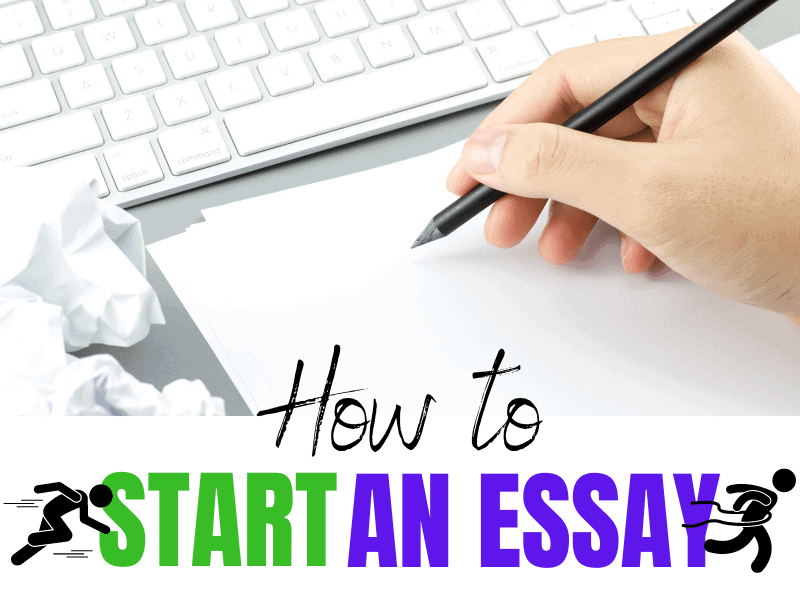
How to Start an Essay with Strong Hooks and Leads

Top 5 Essay Writing Tips

How to write a perfect 5 Paragraph Essay
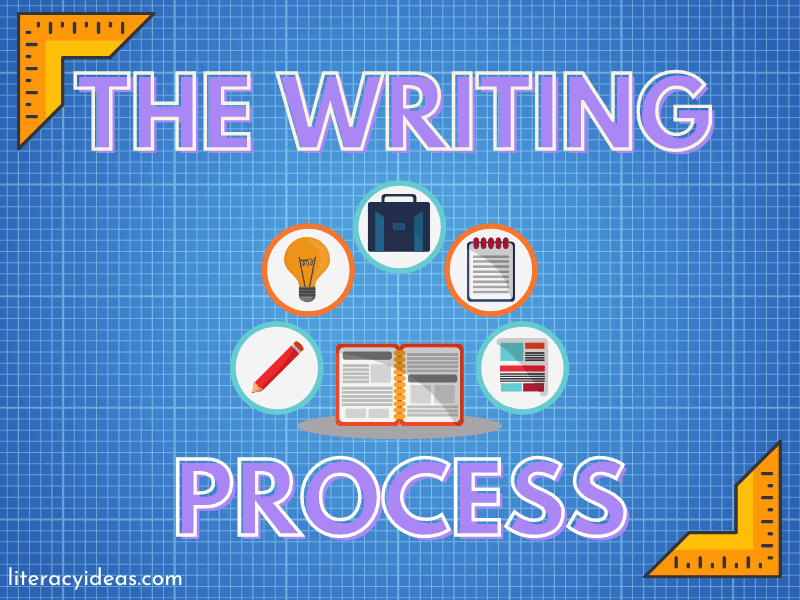
The Writing Process
MAKE WAVES WITH THIS FREE WEEKLONG VOCABULARY UNIT!

How to Teach Paragraph Writing – Write a Conclusion Sentence
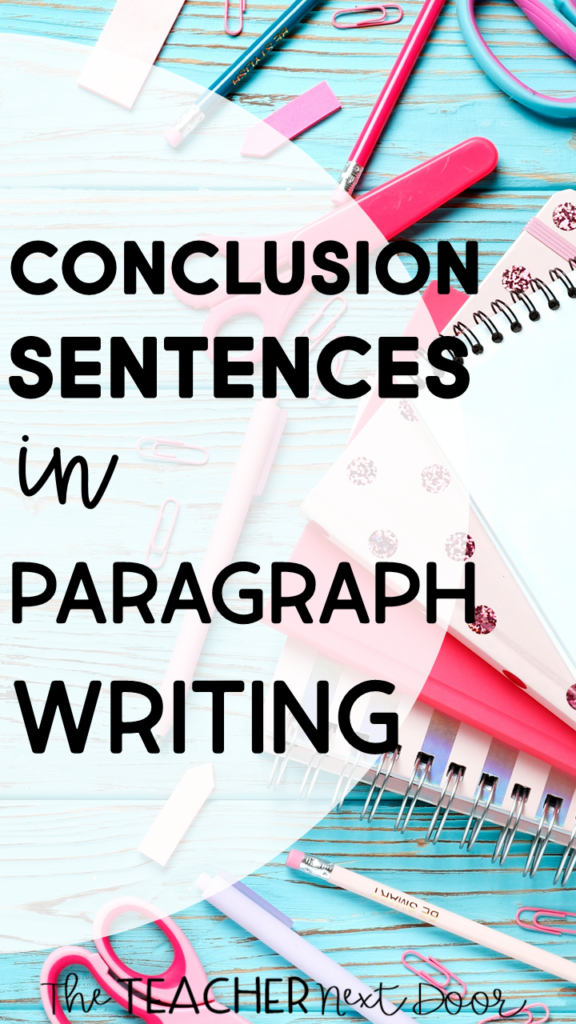
Teaching conclusions is one of the most difficult parts of teaching students to write well-written paragraphs.
Students may be able to write a topic sentence and three supporting ideas with details, but when it comes time to add a conclusion sentence, it’s almost like they’ve run out of steam.
To me, this makes it even more important that as a teacher, I spend a good amount of time specifically explaining how to write conclusions, while scaffolding practice before throwing the little birdies out of the nest.
In this third of a four-part series on Teaching Paragraph Writing, I’ll tell you what has worked for me in my classroom…not promising miracles but hoping you’ll be able to take away something here to make the process a bit easier in your classroom.
Missed the other posts? Here they are if you’d like to read them: Topic Sentences , Supporting Ideas and Details, and Transitions.
1. Explain the Purpose of a Conclusion Sentence
Here’s where we revisit the idea of a conclusion sentence and look at it more in-depth. We talk about why writers use conclusions…mainly to wrap it all up and to give a signal to the reader that the paragraph or essay is ending.
We also talk about what makes a good conclusion vs. what makes a weak or bad one. Strong conclusions are similar to the topic sentence but not TOO similar. Strong conclusions focus on the big idea of the paragraph and NOT on one of the more minor details. Strong conclusions also stay on topic. No new idea is introduced here.
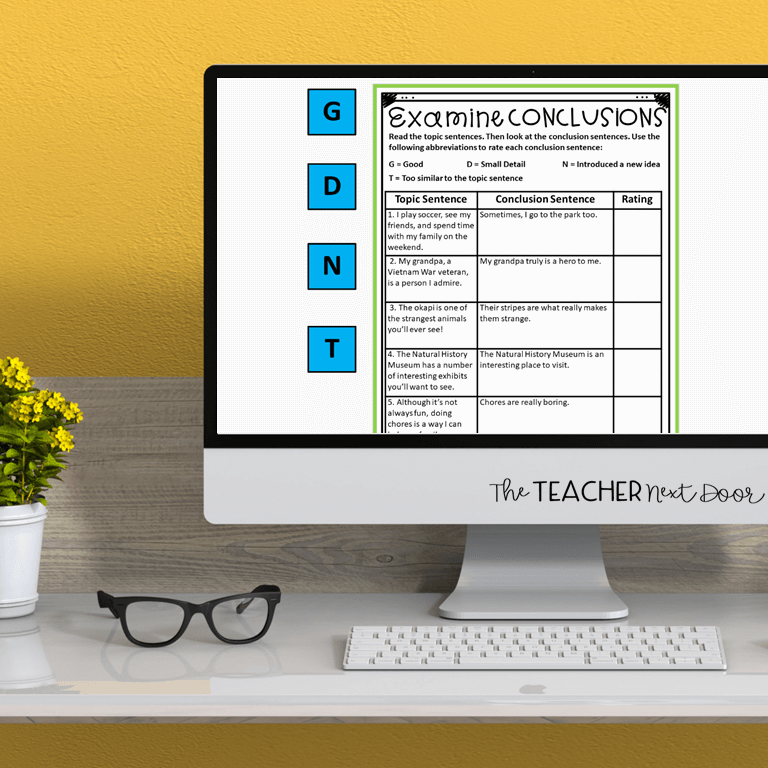
One of the activities I really love doing with my students (and they love it too) is analyzing pre-made conclusion sentences. I put these up on the document projector (no copies for students this first time) and I have students give me a thumbs up or down for each conclusion sentence example. Then we discuss why the example was a good conclusion or not.
This kind of practice is great to help students learn to write conclusion sentences because not only is it non-threatening (way easier than coming up with your own conclusion sentence), it models positive examples while showing students examples to avoid.
On the second day, I hand out a similar worksheet and have students determine (independently or in pairs) if the conclusion is a good one or not. We correct these together and discuss them as we go.
You can sure make up your own conclusion examples if you’d like, but if you’re looking for a print-and-go complete resource for conclusion sentences, I do have one here:
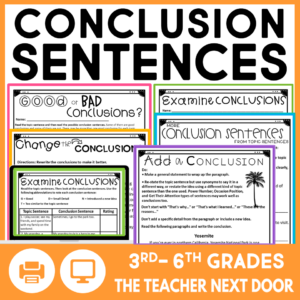
2. Focus on Re-wording the Topic Sentence
One of the ways to make a good conclusion sentence is to reword the topic sentence. We talk about how we can use synonyms and slightly different wording to make the conclusion somewhat similar to the topic sentence but unique enough that it works.
I show students a topic sentence and write it on the SmartBoard if needed. Then I ask them to reword it on whiteboards to make it into a conclusion . This activity helps everyone practice making conclusion sentences. It’s also great for those having trouble, as they’re able to hear other students come up with good examples they might use later.
Once we’ve practiced these, I use some worksheets that are similar to this idea from the conclusions packet and students do independent work with this concept.
3. Use a Different Type of Sentence from the Topic Sentence
When I teach students about topic sentences, I make sure to teach them five basic types of topic sentences including List Statements, Number Words, Occasion-Position, Two Nouns, and Two Commas, and Get Their Attention. See the Topic Sentences post for more information .
Since students already have a good understanding of the five types of topic sentences I teach, I explain to them that one way to make a good conclusion is to use a different type of sentence from the topic sentence to make it into a conclusion.
So, if you used one type of sentence for the topic sentence, choose a different type of sentence for the conclusion. For example, if I used Occasion Position for the topic sentence, I might try using a Number Words sentence for the conclusion. Careful though, generally, “List Statements” don’t work well as a conclusion sentence.
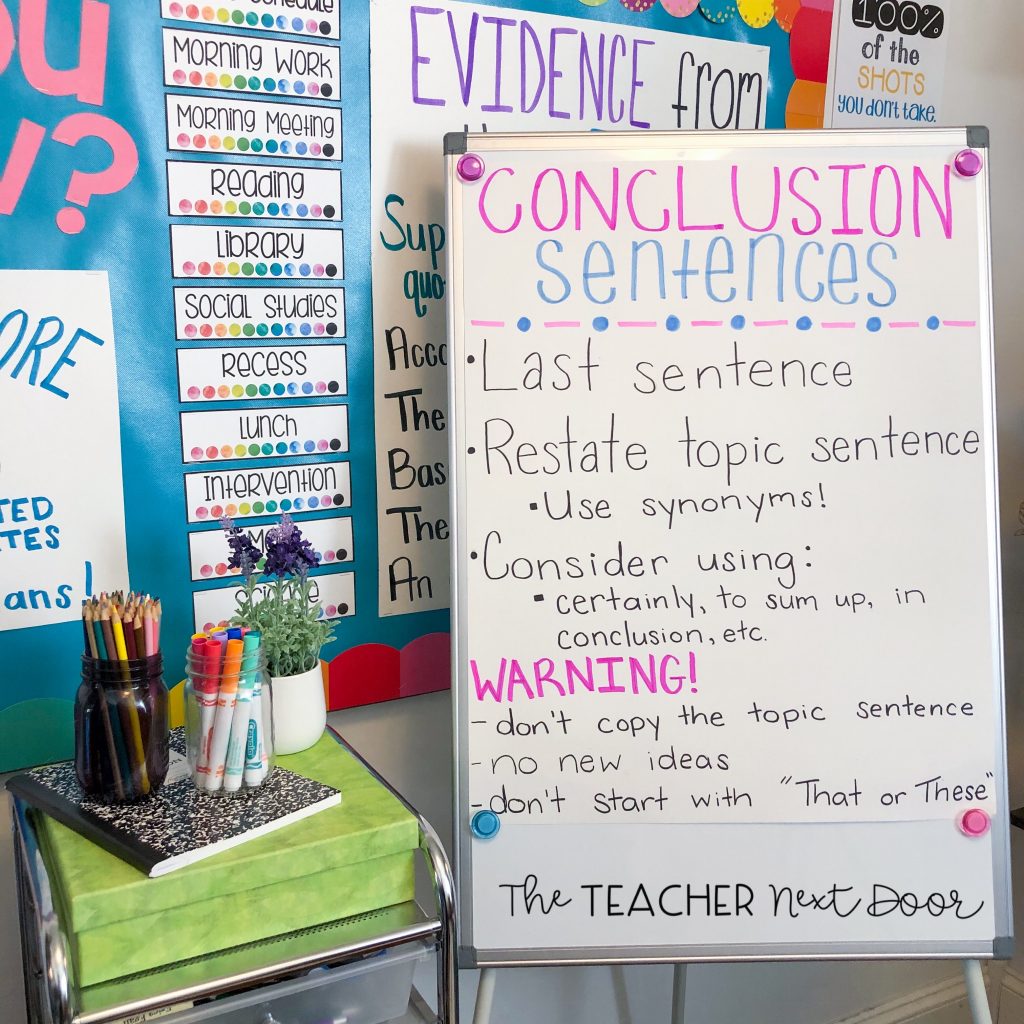
4. Make an Opinion Statement
One idea that has really helped my students write conclusions is to have them practice writing the conclusion as an opinion statement.
So, if the paragraph is about taking care of a dog, the conclusion could be an opinion statement like Dogs make great pets and are excellent companions. If the paragraph is about a Disneyland trip, the conclusion might be Disneyland is a great place to visit. For some reason, these types of conclusion sentences seem to come more naturally to students than other ones do.
5. Teach Optional Conclusion Transition Words
Teaching students a shortlist of transition words for the conclusion can also be helpful. This provides students with a way to start that last and sometimes difficult sentence.
Plus, it does provide a good signal to the reader that the paragraph is coming to a close. Some words/phrases we use include: As you can see…In conclusion…Finally…Obviously…Clearly…Certainly… I do make sure to tell students that these words are a matter of preference and NOT a must.
6. Conclusion Corrections
One last piece of advice for conclusions. Every year there is a conclusion habit that I work hard to correct. I’m not sure why so many students use these types of conclusions but to me, these conclusions make me cringe.
The weak conclusion students often fall back on starts with “That’s why…” or “Those are the reasons why…” and while I guess their teachers were just giving them a quick and easy way to end a paragraph, I just wish they had NOT given them ones that were this bad!
Sorry, but it’s a soapbox issue for me. If you teach a quick and easy way, please don’t teach a bad habit that needs to be corrected later on. So, my students know that they are not allowed to start conclusions this way and will be “dinged” if they do!
Whew…as I said, conclusions are definitely a concept that can be tough for so many students. The more we practice them though, the more they are able to rise to the occasion. I have seen a tremendous amount of growth in my students each year as writers.
Once again, you can make resources to use to help your students become better paragraph writers but if you’d like a low-prep print and a no-prep digital unit to save time, this might be the resource for you. Click here to take a look at the Complete Paragraph Writing Bundle .
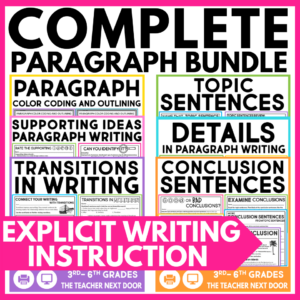
If you’d like to get more teaching ideas for paragraph writing, here are a few posts you might like:
Topic Sentences
Supporting Ideas and Details
Transitions
5 Tips for More Effective Paragraph Writing
Thanks so much for hanging in there with this long post!
Hope it was useful to you in some way!

- Read more about: Writing & Grammar
You might also like...
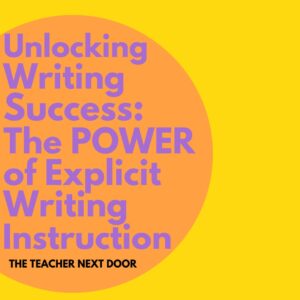
Unlocking Student Writing Success: The Power of Explicit Writing Instruction
As upper elementary teachers, our goal is to create strong writers. However, the lack of Explicit Writing Instruction has caused students in the US to
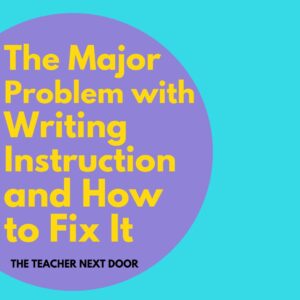
The Major Problem with Writing Instruction and How to Fix It
Writing instruction at the elementary level needs an overhaul. The last time the National Assessment of Education Progress (NAEP) measured 8th-grade students’ writing proficiency in
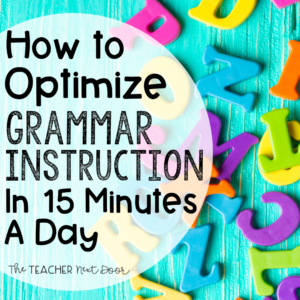
How to Optimize Grammar Instruction in 15 Minutes a Day
As elementary school teachers, we are always thinking about how to integrate subjects. History content and nonfiction text features. A science equation and a math
Hi, I’m Jenn, CEO and owner of The Teacher Next Door!
I know that you strive to be an effective upper elementary teacher while maintaining a healthy work-life balance.
In order to do that, you need resources that are impactful, yet simple .
The problem is that most resources and curriculums out there are far from simple. The pages upon pages of daily lesson plans are just plain overwhelming .
At TTND, we believe teachers should be living their lives outside of the classroom, and not spend hours lesson planning and searching for resources.
We understand that now, more than ever, teachers need space to be themselves which is why we create and support teachers with timesaving tips and standards-aligned resources.
Want access to TTND's Free Resource Library? Sign up for our newsletter and we'll email you the exclusive password!
Trending posts.

SEARCH BY TOPIC
- Classroom Ideas
- Holidays and Seasonal
- Mentor Texts
- Reading Block
- Uncategorized
- Writing & Grammar
POPULAR RESOURCES

Facebook Group
Teachers Pay Teachers
Free Resource Library
💌 Contact Us
Disclosures
Privacy Policy
Refund Policy
Purchase Orders
Your Downloads
Reward Points
© The Teacher Next Door, LLC. All rights reserved.

* Please note: If your school has strong email filters, you may wish to use your personal email to ensure access.

How to Write a Conclusion for an Essay

By the time you get to the final paragraph of your paper, you have already done so much work on your essay, so all you want to do is to wrap it up as quickly as possible. You’ve already made a stunning introduction, proven your argument, and structured the whole piece as supposed – who cares about making a good conclusion paragraph?
The only thing you need to remember is that the conclusion of an essay is not just the last paragraph of an academic paper where you restate your thesis and key arguments. A concluding paragraph is also your opportunity to have a final impact on your audience.
Feeling Overwhelmed Writing Your Essay Conclusion?
Simply send us your paper requirements, choose a writer and we’ll get it done fast.
How to write a conclusion paragraph that leaves a lasting impression – In this guide, the team at EssayPro is going to walk you through the process of writing a perfect conclusion step by step. Additionally, we will share valuable tips and tricks to help students of all ages impress their readers at the last moment.
Instead of Intro: What Is a Conclusion?
Before we can move on, let’s take a moment here to define the conclusion itself. According to the standard conclusion definition, it is pretty much the last part of something, its result, or end. However, this term is rather broad and superficial.
When it comes to writing academic papers, a concluding statement refers to an opinion, judgment, suggestion, or position arrived at by logical reasoning (through the arguments provided in the body of the text). Therefore, if you are wondering “what is a good closing sentence like?” – keep on reading.
What Does a Good Conclusion Mean?
Writing a good conclusion for a paper isn’t easy. However, we are going to walk you through this process step by step. Although there are generally no strict rules on how to formulate one, there are some basic principles that everyone should keep in mind. In this section, we will share some core ideas for writing a good conclusion, and, later in the article, we will also provide you with more practical advice and examples.

Here are the core goals a good conclusion should complete:
- “Wrap up” the entire paper;
- Demonstrate to readers that the author accomplished what he/she set out to do;
- Show how you the author has proved their thesis statement;
- Give a sense of completeness and closure on the topic;
- Leave something extra for your reader to think about;
- Leave a powerful final impact on a reader.
Another key thing to remember is that you should not introduce any new ideas or arguments to your paper's conclusion. It should only sum up what you have already written, revisit your thesis statement, and end with a powerful final impression.
When considering how to write a conclusion that works, here are the key points to keep in mind:
- A concluding sentence should only revisit the thesis statement, not restate it;
- It should summarize the main ideas from the body of the paper;
- It should demonstrate the significance and relevance of your work;
- An essay’s conclusion should include a call for action and leave space for further study or development of the topic (if necessary).
How Long Should a Conclusion Be?
Although there are no strict universal rules regarding the length of an essay’s final clause, both teachers and experienced writers recommend keeping it clear, concise, and straight to the point. There is an unspoken rule that the introduction and conclusion of an academic paper should both be about 10% of the overall paper’s volume. For example, if you were assigned a 1500 word essay, both the introductory and final clauses should be approximately 150 words long (300 together).
Why You Need to Know How to End an Essay:
A conclusion is what drives a paper to its logical end. It also drives the main points of your piece one last time. It is your last opportunity to impact and impress your audience. And, most importantly, it is your chance to demonstrate to readers why your work matters. Simply put, the final paragraph of your essay should answer the last important question a reader will have – “So what?”
If you do a concluding paragraph right, it can give your readers a sense of logical completeness. On the other hand, if you do not make it powerful enough, it can leave them hanging, and diminish the effect of the entire piece.
Strategies to Crafting a Proper Conclusion
Although there are no strict rules for what style to use to write your conclusion, there are several strategies that have been proven to be effective. In the list below, you can find some of the most effective strategies with some good conclusion paragraph examples to help you grasp the idea.
One effective way to emphasize the significance of your essay and give the audience some thought to ponder about is by taking a look into the future. The “When and If” technique is quite powerful when it comes to supporting your points in the essay’s conclusion.
Prediction essay conclusion example: “Taking care of a pet is quite hard, which is the reason why most parents refuse their children’s requests to get a pet. However, the refusal should be the last choice of parents. If we want to inculcate a deep sense of responsibility and organization in our kids, and, at the same time, sprout compassion in them, we must let our children take care of pets.”
Another effective strategy is to link your conclusion to your introductory paragraph. This will create a full-circle narration for your readers, create a better understanding of your topic, and emphasize your key point.
Echo conclusion paragraph example: Introduction: “I believe that all children should grow up with a pet. I still remember the exact day my parents brought my first puppy to our house. This was one of the happiest moments in my life and, at the same time, one of the most life-changing ones. Growing up with a pet taught me a lot, and most importantly, it taught me to be responsible.” Conclusion:. “I remember when I picked up my first puppy and how happy I was at that time. Growing up with a pet, I learned what it means to take care of someone, make sure that he always has water and food, teach him, and constantly keep an eye on my little companion. Having a child grow up with a pet teaches them responsibility and helps them acquire a variety of other life skills like leadership, love, compassion, and empathy. This is why I believe that every kid should grow up with a pet!”
Finally, one more trick that will help you create a flawless conclusion is to amplify your main idea or to present it in another perspective of a larger context. This technique will help your readers to look at the problem discussed from a different angle.
Step-up argumentative essay conclusion example: “Despite the obvious advantages of owning a pet in childhood, I feel that we cannot generalize whether all children should have a pet. Whereas some kids may benefit from such experiences, namely, by becoming more compassionate, organized, and responsible, it really depends on the situation, motivation, and enthusiasm of a particular child for owning a pet.”
What is a clincher in an essay? – The final part of an essay’s conclusion is often referred to as a clincher sentence. According to the clincher definition, it is a final sentence that reinforces the main idea or leaves the audience with an intriguing thought to ponder upon. In a nutshell, the clincher is very similar to the hook you would use in an introductory paragraph. Its core mission is to seize the audience’s attention until the end of the paper. At the same time, this statement is what creates a sense of completeness and helps the author leave a lasting impression on the reader.
Now, since you now know what a clincher is, you are probably wondering how to use one in your own paper. First of all, keep in mind that a good clincher should be intriguing, memorable, smooth, and straightforward.
Generally, there are several different tricks you can use for your clincher statement; it can be:
- A short, but memorable and attention-grabbing conclusion;
- A relevant and memorable quote (only if it brings actual value);
- A call to action;
- A rhetorical question;
- An illustrative story or provocative example;
- A warning against a possibility or suggestion about the consequences of a discussed problem;
- A joke (however, be careful with this as it may not always be deemed appropriate).
Regardless of the technique you choose, make sure that your clincher is memorable and aligns with your introduction and thesis.
Clincher examples: - While New York may not be the only place with the breathtaking views, it is definitely among my personal to 3… and that’s what definitely makes it worth visiting. - “Thence we came forth to rebehold the stars”, Divine Comedy - Don’t you think all these advantages sound like almost life-saving benefits of owning a pet? “So we beat on, boats against the current, borne back ceaselessly into the past.”, The Great Gatsby

Conclusion Writing Don'ts
Now, when you know what tricks and techniques you should use to create a perfect conclusion, let’s look at some of the things you should not do with our online paper writing service :
- Starting with some cliché concluding sentence starters. Many students find common phrases like “In conclusion,” “Therefore,” “In summary,” or similar statements to be pretty good conclusion starters. However, though such conclusion sentence starters may work in certain cases – for example, in speeches – they are overused, so it is recommended not to use them in writing to introduce your conclusion.
- Putting the first mention of your thesis statement in the conclusion – it has to be presented in your introduction first.
- Providing new arguments, subtopics, or ideas in the conclusion paragraph.
- Including a slightly changed or unchanged thesis statement.
- Providing arguments and evidence that belong in the body of the work.
- Writing too long, hard to read, or confusing sentences.
In case, you have written a conclusion, but you're not sure if it’s good enough?
EssayPro provides all kinds of writing assistance. Send your work to one of our top writers to get it reviewed in no time.
Conclusion Paragraph Outline
The total number of sentences in your final paragraph may vary depending on the number of points you discussed in your essay, as well as on the overall word count of your paper. However, the overall conclusion paragraph outline will remain the same and consists of the following elements:

- A conclusion starter:
The first part of your paragraph should drive readers back to your thesis statement. Thus, if you were wondering how to start a conclusion, the best way to do it is by rephrasing your thesis statement.
- Summary of the body paragraphs:
Right after revisiting your thesis, you should include several sentences that wrap up the key highlights and points from your body paragraphs. This part of your conclusion can consist of 2-3 sentences—depending on the number of arguments you’ve made. If necessary, you can also explain to the readers how your main points fit together.
- A concluding sentence:
Finally, you should end your paragraph with a last, powerful sentence that leaves a lasting impression, gives a sense of logical completeness, and connects readers back to the introduction of the paper.
These three key elements make up a perfect essay conclusion. Now, to give you an even better idea of how to create a perfect conclusion, let us give you a sample conclusion paragraph outline with examples from an argumentative essay on the topic of “Every Child Should Own a Pet:
- Sentence 1: Starter
- ~ Thesis: "Though taking care of a pet may be a bit challenging for small children. Parents should not restrict their kids from having a pet as it helps them grow into more responsible and compassionate people."
- ~ Restated thesis for a conclusion: "I can say that taking care of a pet is good for every child."
- Sentences 2-4: Summary
- ~ "Studies have shown that pet owners generally have fewer health problems."
- ~ "Owning a pet teaches a child to be more responsible."
- ~ "Spending time with a pet reduces stress, feelings of loneliness, and anxiety."
- Sentence 5: A concluding sentence
- ~ "Pets can really change a child life for the better, so don't hesitate to endorse your kid's desire to own a pet."
This is a clear example of how you can shape your conclusion paragraph.
How to Conclude Various Types of Essays
Depending on the type of academic essay you are working on, your concluding paragraph's style, tone, and length may vary. In this part of our guide, we will tell you how to end different types of essays and other works.
How to End an Argumentative Essay
Persuasive or argumentative essays always have the single goal of convincing readers of something (an idea, stance, or viewpoint) by appealing to arguments, facts, logic, and even emotions. The conclusion for such an essay has to be persuasive as well. A good trick you can use is to illustrate a real-life scenario that proves your stance or encourages readers to take action. More about persuasive essay outline you can read in our article.
Here are a few more tips for making a perfect conclusion for an argumentative essay:
- Carefully read the whole essay before you begin;
- Re-emphasize your ideas;
- Discuss possible implications;
- Don’t be afraid to appeal to the reader’s emotions.
How to End a Compare and Contrast Essay
The purpose of a compare and contrast essay is to emphasize the differences or similarities between two or more objects, people, phenomena, etc. Therefore, a logical conclusion should highlight how the reviewed objects are different or similar. Basically, in such a paper, your conclusion should recall all of the key common and distinctive features discussed in the body of your essay and also give readers some food for thought after they finish reading it.
How to Conclude a Descriptive Essay
The key idea of a descriptive essay is to showcase your creativity and writing skills by painting a vivid picture with the help of words. This is one of the most creative types of essays as it requires you to show a story, not tell it. This kind of essay implies using a lot of vivid details. Respectively, the conclusion of such a paper should also use descriptive imagery and, at the same time, sum up the main ideas. A good strategy for ending a descriptive essay would be to begin with a short explanation of why you wrote the essay. Then, you should reflect on how your topic affects you. In the middle of the conclusion, you should cover the most critical moments of the story to smoothly lead the reader into a logical closing statement. The “clincher”, in this case, should be a thought-provoking final sentence that leaves a good and lasting impression on the audience. Do not lead the reader into the essay and then leave them with dwindling memories of it.
How to Conclude an Essay About Yourself
If you find yourself writing an essay about yourself, you need to tell a personal story. As a rule, such essays talk about the author’s experiences, which is why a conclusion should create a feeling of narrative closure. A good strategy is to end your story with a logical finale and the lessons you have learned, while, at the same time, linking it to the introductory paragraph and recalling key moments from the story.
How to End an Informative Essay
Unlike other types of papers, informative or expository essays load readers with a lot of information and facts. In this case, “Synthesize, don’t summarize” is the best technique you can use to end your paper. Simply put, instead of recalling all of the major facts, you should approach your conclusion from the “So what?” position by highlighting the significance of the information provided.
How to Conclude a Narrative Essay
In a nutshell, a narrative essay is based on simple storytelling. The purpose of this paper is to share a particular story in detail. Therefore, the conclusion for such a paper should wrap up the story and avoid finishing on an abrupt cliffhanger. It is vital to include the key takeaways and the lessons learned from the story.
How to Write a Conclusion for a Lab Report
Unlike an essay, a lab report is based on an experiment. This type of paper describes the flow of a particular experiment conducted by a student and its conclusion should reflect on the outcomes of this experiment.
In thinking of how to write a conclusion for a lab, here are the key things you should do to get it right:
- Restate the goals of your experiment
- Describe the methods you used
- Include the results of the experiment and analyze the final data
- End your conclusion with a clear statement on whether or not the experiment was successful (Did you reach the expected results?)
How to Write a Conclusion for a Research Paper
Writing a paper is probably the hardest task of all, even for experienced dissertation writer . Unlike an essay or even a lab report, a research paper is a much longer piece of work that requires a deeper investigation of the problem. Therefore, a conclusion for such a paper should be even more sophisticated and powerful. If you're feeling difficulty writing an essay, you can buy essay on our service.

However, given that a research paper is the second most popular kind of academic paper (after an essay), it is important to know how to conclude a research paper. Even if you have not yet been assigned to do this task, be sure that you will face it soon. So, here are the steps you should follow to create a great conclusion for a research paper:
- Restate the Topic
Start your final paragraph with a quick reminder of what the topic of the piece is about. Keep it one sentence long.
- Revisit the Thesis
Next, you should remind your readers what your thesis statement was. However, do not just copy and paste it from the introductory clause: paraphrase your thesis so that you deliver the same idea but with different words. Keep your paraphrased thesis narrow, specific, and topic-oriented.
- Summarise Your Key Ideas
Just like the case of a regular essay’s conclusion, a research paper’s final paragraph should also include a short summary of all of the key points stated in the body sections. We recommend reading the entire body part a few times to define all of your main arguments and ideas.
- Showcase the Significance of Your Work
In the research paper conclusion, it is vital to highlight the significance of your research problem and state how your solution could be helpful.
- Make Suggestions for Future Studies
Finally, at the end of your conclusion, you should define how your findings will contribute to the development of its particular field of science. Outline the perspectives of further research and, if necessary, explain what is yet to be discovered on the topic.
Then, end your conclusion with a powerful concluding sentence – it can be a rhetorical question, call to action, or another hook that will help you have a strong impact on the audience.
- Answer the Right Questions
To create a top-notch research paper conclusion, be sure to answer the following questions:
- What is the goal of a research paper?
- What are the possible solutions to the research question(s)?
- How can your results be implemented in real life? (Is your research paper helpful to the community?)
- Why is this study important and relevant?
Additionally, here are a few more handy tips to follow:
- Provide clear examples from real life to help readers better understand the further implementation of the stated solutions;
- Keep your conclusion fresh, original, and creative.
Address to our term paper writers if you need to proofread or rewrite essay.
Want to Have Better Grades?
Address to our professionals and get your task done asap!
So, What Is a Good Closing Sentence? See The Difference
One of the best ways to learn how to write a good conclusion is to look at several professional essay conclusion examples. In this section of our guide, we are going to look at two different final paragraphs shaped on the basis of the same template, but even so, they are very different – where one is weak and the other is strong. Below, we are going to compare them to help you understand the difference between a good and a bad conclusion.
Here is the template we used: College degrees are in decline. The price of receiving an education does not correlate with the quality of the education received. As a result, graduated students face underemployment, and the worth of college degrees appears to be in serious doubt. However, the potential social and economic benefits of educated students balance out the equation.
Strong Conclusion
People either see college as an opportunity or an inconvenience; therefore, a degree can only hold as much value as its owner’s skillset. The underemployment of graduate students puts the worth of college degrees in serious doubt. Yet, with the multitude of benefits that educated students bring to society and the economy, the equation remains in balance. Perhaps the ordinary person should consider college as a wise financial investment, but only if they stay determined to study and do the hard work.
Why is this example good? There are several key points that prove its effectiveness:
- There is a bold opening statement that encompasses the two contrasting types of students we can see today.
- There are two sentences that recall the thesis statement and cover the key arguments from the body of the essay.
- Finally, the last sentence sums up the key message of the essay and leaves readers with something to think about.
Weak Conclusion
In conclusion, with the poor preparation of students in college and the subsequent underemployment after graduation from college, the worth associated with the college degree appears to be in serious doubt. However, these issues alone may not reasonably conclude beyond a doubt that investing in a college degree is a rewarding venture. When the full benefits that come with education are carefully put into consideration and evaluated, college education for children in any country still has good advantages, and society should continue to advocate for a college education. The ordinary person should consider this a wise financial decision that holds rewards in the end. Apart from the monetary gains associated with a college education, society will greatly benefit from students when they finish college. Their minds are going to be expanded, and their reasoning and decision making will be enhanced.
What makes this example bad? Here are a few points to consider:
- Unlike the first example, this paragraph is long and not specific enough. The author provides plenty of generalized phrases that are not backed up by actual arguments.
- This piece is hard to read and understand and sentences have a confusing structure. Also, there are lots of repetitions and too many uses of the word “college”.
- There is no summary of the key benefits.
- The last two sentences that highlight the value of education contradict with the initial statement.
- Finally, the last sentence doesn’t offer a strong conclusion and gives no thought to ponder upon.
- In the body of your essay, you have hopefully already provided your reader(s) with plenty of information. Therefore, it is not wise to present new arguments or ideas in your conclusion.
- To end your final paragraph right, find a clear and straightforward message that will have the most powerful impact on your audience.
- Don’t use more than one quote in the final clause of your paper – the information from external sources (including quotes) belongs in the body of a paper.
- Be authoritative when writing a conclusion. You should sound confident and convincing to leave a good impression. Sentences like “I’m not an expert, but…” will most likely make you seem less knowledgeable and/or credible.
Good Conclusion Examples
Now that we've learned what a conclusion is and how to write one let's take a look at some essay conclusion examples to strengthen our knowledge.
The ending ironically reveals that all was for nothing. (A short explanation of the thematic effect of the book’s end) Tom says that Miss Watson freed Jim in her final will.Jim told Huck that the dead man on the Island was pap. The entire adventure seemingly evaporated into nothingness. (How this effect was manifested into the minds of thereaders).
All in all, international schools hold the key to building a full future that students can achieve. (Thesis statement simplified) They help students develop their own character by learning from their mistakes, without having to face a dreadful penalty for failure. (Thesis statement elaborated)Although some say that kids emerged “spoiled” with this mentality, the results prove the contrary. (Possible counter-arguments are noted)
In conclusion, public workers should be allowed to strike since it will give them a chance to air their grievances. (Thesis statement) Public workers should be allowed to strike when their rights, safety, and regulations are compromised. The workers will get motivated when they strike, and their demands are met.
In summary, studies reveal some similarities in the nutrient contents between the organic and non-organic food substances. (Starts with similarities) However, others have revealed many considerable differences in the amounts of antioxidants as well as other minerals present in organic and non-organic foods. Generally, organic foods have higher levels of antioxidants than non-organic foods and therefore are more important in the prevention of chronic illnesses.
As time went by, my obsession grew into something bigger than art; (‘As time went by’ signals maturation) it grew into a dream of developing myself for the world. (Showing student’s interest of developing himself for the community) It is a dream of not only seeing the world from a different perspective but also changing the perspective of people who see my work. (Showing student’s determination to create moving pieces of art)
In conclusion, it is evident that technology is an integral part of our lives and without it, we become “lost” since we have increasingly become dependent on its use. (Thesis with main point)
You might also be interested in reading nursing essay examples from our service.
Related Articles
%20(1).webp)
EL Education Curriculum
You are here.
- ELA 2019 G8:M2:U3:L10
Write a Practice Argument Essay: Analyze and Draft a Conclusion
In this lesson, daily learning targets, ongoing assessment.
- Technology and Multimedia
Supporting English Language Learners
Materials from previous lessons, new materials, closing & assessments, you are here:.
- ELA 2019 Grade 8
- ELA 2019 G8:M2
- ELA 2019 G8:M2:U3
Like what you see?
Order printed materials, teacher guides and more.
How to order
Help us improve!
Tell us how the curriculum is working in your classroom and send us corrections or suggestions for improving it.
Leave feedback
Focus Standards: These are the standards the instruction addresses.
- W.8.1, W.8.1e, W.8.4, W.8.5, W.8.10
Supporting Standards: These are the standards that are incidental—no direct instruction in this lesson, but practice of these standards occurs as a result of addressing the focus standards.
- RI.8.1, RI.8.4, RI.8.10, W.8.6, SL.8.1, SL.8.4, L.8.4, L.8.6
- I can identify the purpose of each part of the conclusion paragraph of a model argument essay. ( W.8.1e )
- I can write the conclusion of my practice argument essay. ( W.8.1e, W.8.4 )
- Opening: Entrance Ticket: Unit 3, Lesson 10 ( W.8.1 )
- Work Time A: Annotated Model Essay ( W.8.1e )
- Work Time B: Conclusion of Practice Argument Essay ( W.8.1e, W.8.4 )
- Prepare Entrance Ticket: Unit 3, Lesson 10 (one per student), and ensure there is a copy at each student's workspace.
- Review the Argument Writing checklist to become familiar with what will be required of students over the remainder of the unit.
- Post the learning targets and applicable anchor charts (see Materials list).
Tech and Multimedia
- Work Time C: Prepare devices with word-processing capabilities for students to continue drafting.
- Continue to use the technology tools recommended throughout previous modules to create anchor charts to share with families; to record students as they participate in discussions and protocols to review with students later and to share with families; and for students to listen to and annotate text, record ideas on note-catchers, and word-process writing.
Supports guided in part by CA ELD Standards 8.I.C.11 and 8.I.C.12.
Important Points in the Lesson Itself
- To support ELLs, this lesson follows a sequence that closely mirrors that of previous lessons, which will help students to focus on the tasks at hand. Students analyze the conclusion of the model essay and then draft conclusions for the practice argument essay. During Closing and Assessment A, students give one another feedback. This offers an opportunity for supportive learning, as well as meaningful oral skills practice.
- ELLs may find it challenging to articulate their thoughts on Entrance Ticket: Unit 3, Lesson 10 . ELLs may also find it difficult to write a strong conclusion, depending on the strength of the rest of their essays. Prioritize discussion and peer feedback portions of the lesson to build a supportive environment for students as they take on this work. Remind students to be respectful of one another's progress, and invite students to offer suggestions and feedback that is kind, helpful, and specific.
- Characteristics of Argument Writing anchor chart (example for teacher reference) (from Module 2, Unit 3, Lesson 4, Closing A)
- Characteristics of Argument Writing anchor chart (one for display; from Module 2, Unit 3, Lesson 4, Closing A)
- Painted Essay® template (one per student; from Module 1, Unit 3, Lesson 6, Work Time B)
- Model Essay: “Transportation Choices” (one per student; from Module 2, Unit 3, Lesson 4, Work Time A)
- Argument Writing checklist (one per student; from Module 2, Unit 3, Lesson 5)
- Practice Argument Essay Writing Plan graphic organizer (one per student; from Module 2, Unit 3, Lesson 5, Work Time C)
- The Omnivore’s Dilemma (one per student; Module 2, Unit 1, Lesson 1, Closing and Assessment A)
- Independent reading journals (one per student; begun in Module 1, Unit 1, Lesson 6, Work Time B)
- Entrance Ticket: Unit 3, Lesson 10 (example for teacher reference)
- Entrance Ticket: Unit 3, Lesson 10 (one per student)
- Devices (one per student; see Technology and Multimedia)
- Sticky note (one per student)
Each unit in the 6-8 Language Arts Curriculum has two standards-based assessments built in, one mid-unit assessment and one end of unit assessment. The module concludes with a performance task at the end of Unit 3 to synthesize students' understanding of what they accomplished through supported, standards-based writing.
Copyright © 2013-2024 by EL Education, New York, NY.
Get updates about our new K-5 curriculum as new materials and tools debut.
Help us improve our curriculum..
Tell us what’s going well, share your concerns and feedback.
Terms of use . To learn more about EL Education, visit eleducation.org
8th grade writing
by: Hank Pellissier | Updated: February 12, 2024
Print article

Verbal has a double meaning for eighth grade writing: it refers to the oral presentations the kids will do and to this year’s focus on grammar — gerunds, participles, and infinitives.
Argument essays
Written in formal language, argument essays should start with an introduction that clearly presents the writer’s position and flows into a well-organized, research-backed argument that advocates for their position and argues against opposing claims. Your child’s writing should exhibit a profound understanding of the topic. Arguments should be logical and fueled by evidence from credible sources. Papers should end with a persuasive conclusion that summarizes the viewpoint and declares the topic resolved. Topics will vary, but you’ll often see teen issues such as: Are video games harmful to mental health? Should our school have uniforms? Should bullies be suspended or given a chance to make amends?
Informative and explanatory writing
In their informative and explanatory papers , students use formal language to explain complex topics with relevant data, precise ideas, and logical analyses. Kids should start with an intriguing introduction that previews the subject matter. Next, they present well-organized information that’s backed by evidence from credible sources. Eighth graders should use a variety of “strategy tools,” including:
- Classifying information.
- Defining terms.
- Using subject-specific, academic , and transition vocabulary words.
- Quoting sources.
- Incorporating factual details.
- Making comparisons.
- Contrasting different situations.
- Explaining cause-and-effect relationships.
- Including graphics (charts, tables, images) and multimedia.
- Using formatting (headings, bullet points).
Finally, the concluding paragraph should provide a synopsis of the main point of the essay. Your child’s papers are likely to cover topics that students are familiar with — but still need to research in order to answer, like If there is a drought, how can we save water? Or Explain how a specific invention has changed your life .
Narrative writing
Eighth graders write narratives or stories that describe events in their lives (personal histories, memoirs) or imagined scenarios (fiction, fantasy). Junior J.K. Rowlings learn effective storytelling techniques, such as introducing the narrator and characters, establishing context for the setting, and conveying a point of view. Students practice letting the sequence of events unfold, giving characters depth, and developing the plot through actions, dialogue, and reflection. Your future F. Scott Fitzgerald should use transition words to guide readers from one place and time to another. For example: Four hours later, Jack opened his locker to discover a shocking surprise . Or, Returning to the cafeteria, Tinsley saw the cute new boy sitting with her best friend, Amanda . Remember that even narratives have a conclusion, hopefully one that helps readers ponder the meaning of the story.
Changes and more changes
Grit. Concentration. Determination. Eighth graders strengthen their literary skills by revising their papers over and over again, following advice from teachers and classmates to re-imagine, re-outline, redraft, re-edit, rewrite, and try new approaches. Is this just a form of perfectionistic punishment? No, the practice helps teens learn to tighten their prose, pick stronger verbs, use more accurate descriptors, and organize their writing in the most effective and interesting ways.
Internet interaction
Your eighth grader will likely need the internet to create, type, and share their work, which will often have links to web sources and include graphics and multimedia. Also, these are typically typed. Your child should be tying about 40 words per minute. (Wisconsin’s Department of Public Instruction recommends a typing speed 5 times your grade . If your child needs practice, there are free typing classes for middle schoolers available online .)
It’s increasingly common for kids to be required to collaborate on projects online, often in Google Docs or Slides. What’s more, drafts and completed assignments are often turned in via email or by uploading to an online portal. So if your child’s technical skills aren’t up to snuff, think about getting your child a little extra help so these requirements don’t hold him back.
Evaluating their sources
Eighth graders do short projects that require research from multiple sources. Teens learn to evaluate the credibility of their sources. For example, Is Saturday Night Live as reliable as National Public Radio? No. Kids need to be careful about how they present information, paraphrasing information or using quotes to avoid plagiarizing, which Merriam-Webster defines as “to use the words or ideas of another person as if they were your own words or ideas.” The standard way to end all research projects? A bibliography, formatted correctly, of course, that shows both the quality and quantity of their sources.
Student critiques
Students get to do the critiquing this year — whether it’s a book or their classmate’s essay. Eighth graders analyze how modern fiction uses the plot, themes, and characters. Students look for connections and explain how a contemporary text borrows from, comments on, or changes the old foundation. For example, How does The Hunger Games trilogy use the Greek myth of Theseus and the Minotaur?
Students also evaluate the evidence their peers use in essays and to back up arguments. It helps them become more skilled at determining fact from fiction, legitimate truth from biased propaganda, scientific theories from fraudulent nonsense.
Eighth graders learn to identify verb voice. If the subject in a sentence does the action, then the verb is in the active voice, like this: The whale ate the shrimp. However, if the subject in a sentence is the target of the action, then the verb is in the passive voice, like this: The shrimp was eaten by the whale .
Presenting their work
Expect quite a few oral reports in eighth grade. In these presentations, kids need to deliver their arguments and the results of their investigations to the class. Key skills for a solid presentation include:
- using formal language;
- making eye contact;
- pronouncing things clearly and loudly enough for all to hear.
Your child’s presentations should be coherent, organized, logical, supported by evidence, and, in many cases, jazzed up with costumes, props, maps, music, sound effects, charts, and visual projection. Teens (and adults) often suffer from sweaty, knee-knocking stage fright. Inform your adolescent that this is totally normal; remind them to breathe and enjoy the attention.
Here’s a preview of the presentation skills required in high school.

Homes Nearby
Homes for rent and sale near schools

6 ways to improve a college essay

Quick writing tips for every age

Writing on the wall
Why parents must teach writing
Yes! Sign me up for updates relevant to my child's grade.
Please enter a valid email address
Thank you for signing up!
Server Issue: Please try again later. Sorry for the inconvenience

Bell Ringers
Teaching literary analysis in middle school.
My literary analysis resources have basically been seven or eight years in the making.
I don’t know about you, but when I first realized I needed to be teaching literary analysis to a bunch of twelve and thirteen year-olds, I didn’t even know where to begin.
I had been teaching upper elementary in the three years prior, and we had done some on-demand literary analysis reading responses, but really digging into a literary analysis essay overwhelmed me.
Truth be told, my teaching strengths at the time were primarily reading and math. I had always had to dig deep to find my writing teacher voice.
But, I was now a seventh and eighth grade ELA teacher who could no longer hope her students picked up some writing skills along the way.
So I did what any good teacher would do…. I Googled how to teach…
I think I Googled something like, “Examples of middle school literary analysis essays.”
Nothing showed up in Google.
Then I Googled, “How do you teach literary analysis essays?”
I was able to find an example of a college-level literary analysis essay…
… and that was about it.
Because I couldn’t really find what I was looking for, I began creating and practicing each step of the literary analysis essay before I taught it.
This also created a ton of exemplars for my students.
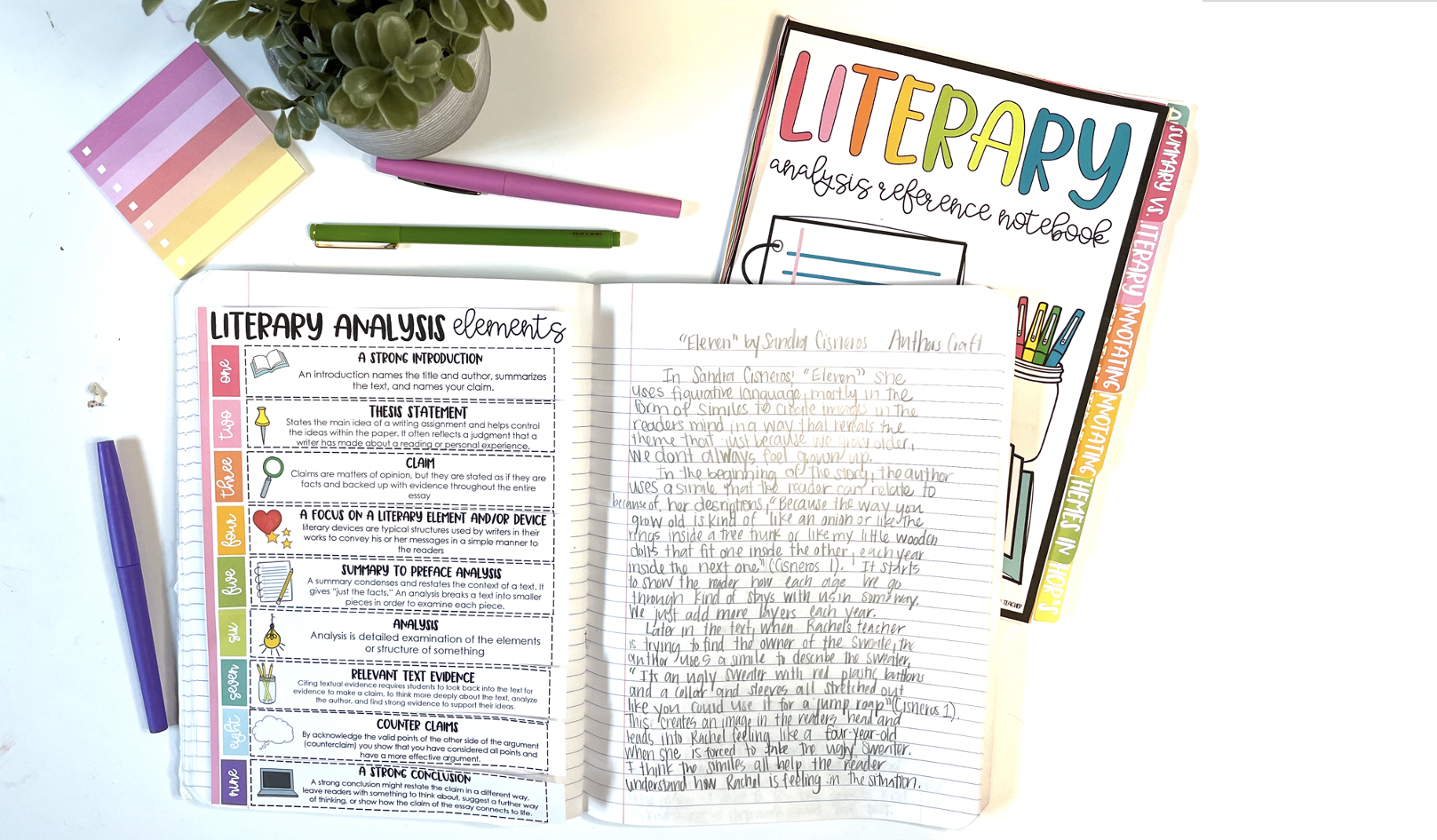
I broke down each area of a literary analysis essay into lessons, chunks, chart papers, reference materials, and writing examples.
In the beginning, it was to get my brain wrapped around things, but not surprisingly it was exactly what my students needed too.
I literally learned how to write a literary analysis essay in front of them.
I would type my rough drafts as they were working and I could stop them as I came to struggles.
My mini-lessons were based on challenges I was having and again, not surprisingly the same challenges they were having.
I could also make reference pages (like the ones in your freebie) as we went along in the unit, because I could see what terms and concepts they needed constant reminders and help with.
Want to know what happened?
My student’s ELA proficiency scores increased 45% in one year and almost 70% in just two years. Those are not typos.
>> CLICK HERE << to download the FREE Literary Analysis Reference Booklet.
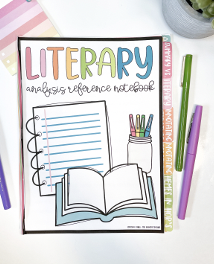
- Read more about: Middle School Reading , Middle School Writing
You might also like...
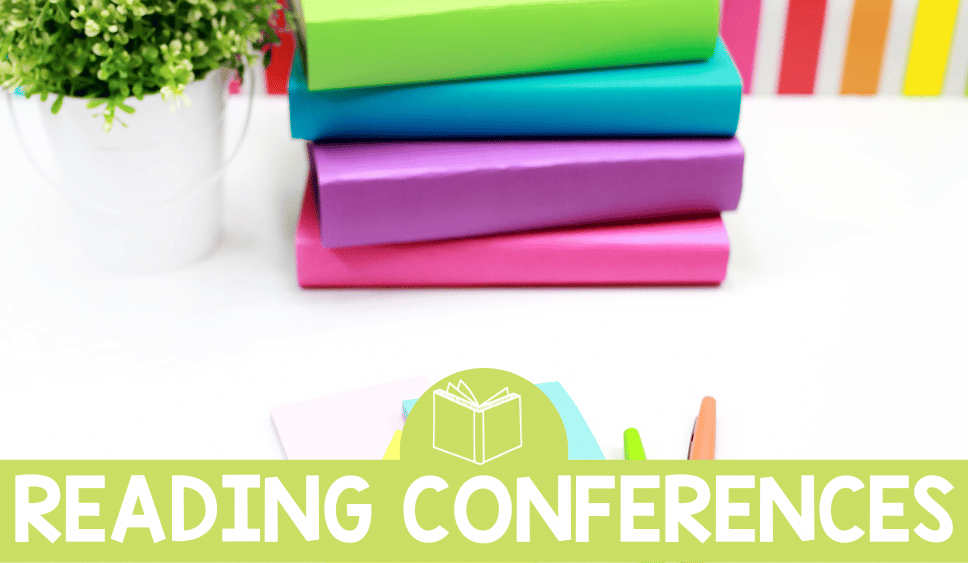
Reading Conferences: The Golden Gate Bridge Method
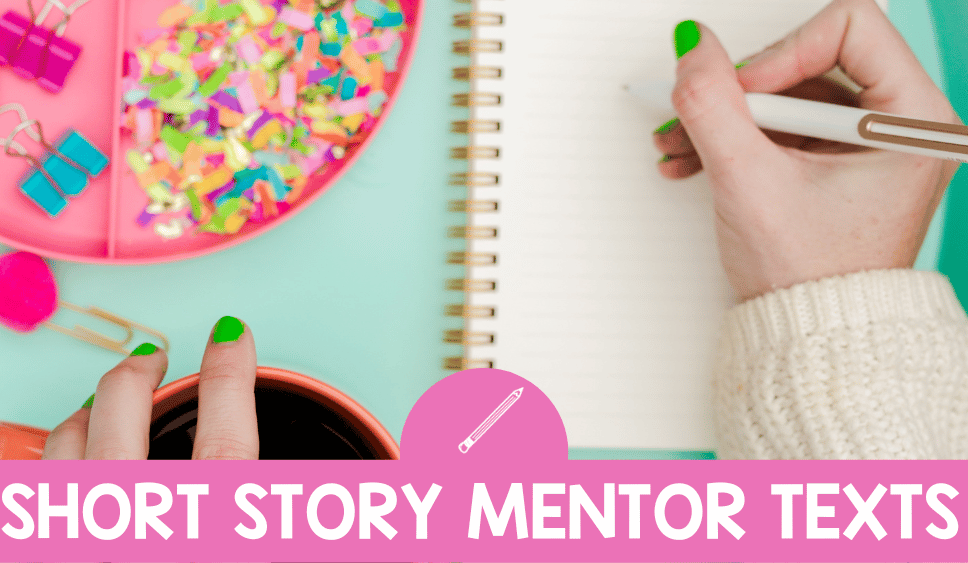
Short Story Mentor Texts to Teach Narrative Writing Elements

Using Mentor Texts for Narrative Writing in Middle School ELA
Get your free middle school ela pacing guides with completed scopes and sequences for the school year..

My ELA scope and sequence guides break down every single middle school ELA standard and concept for reading, writing, and language in 6th, 7th, and 8th grade. Use the guides and resources exactly as is or as inspiration for you own!
Meet Martina

I’m a Middle School ELA teacher committed to helping you improve your teaching & implement systems that help you get everything done during the school day!
Let's Connect
Member login.
PRIVACY POLICY
TERMS OF USE
WEBSITE DISCLAIMERS
MEMBERSHIP AGREEEMENT
© The Hungry Teacher • Website by KristenDoyle.co • Contact Martina
- Try for free
8th Grade Essays
- Most Popular
- Most Recent
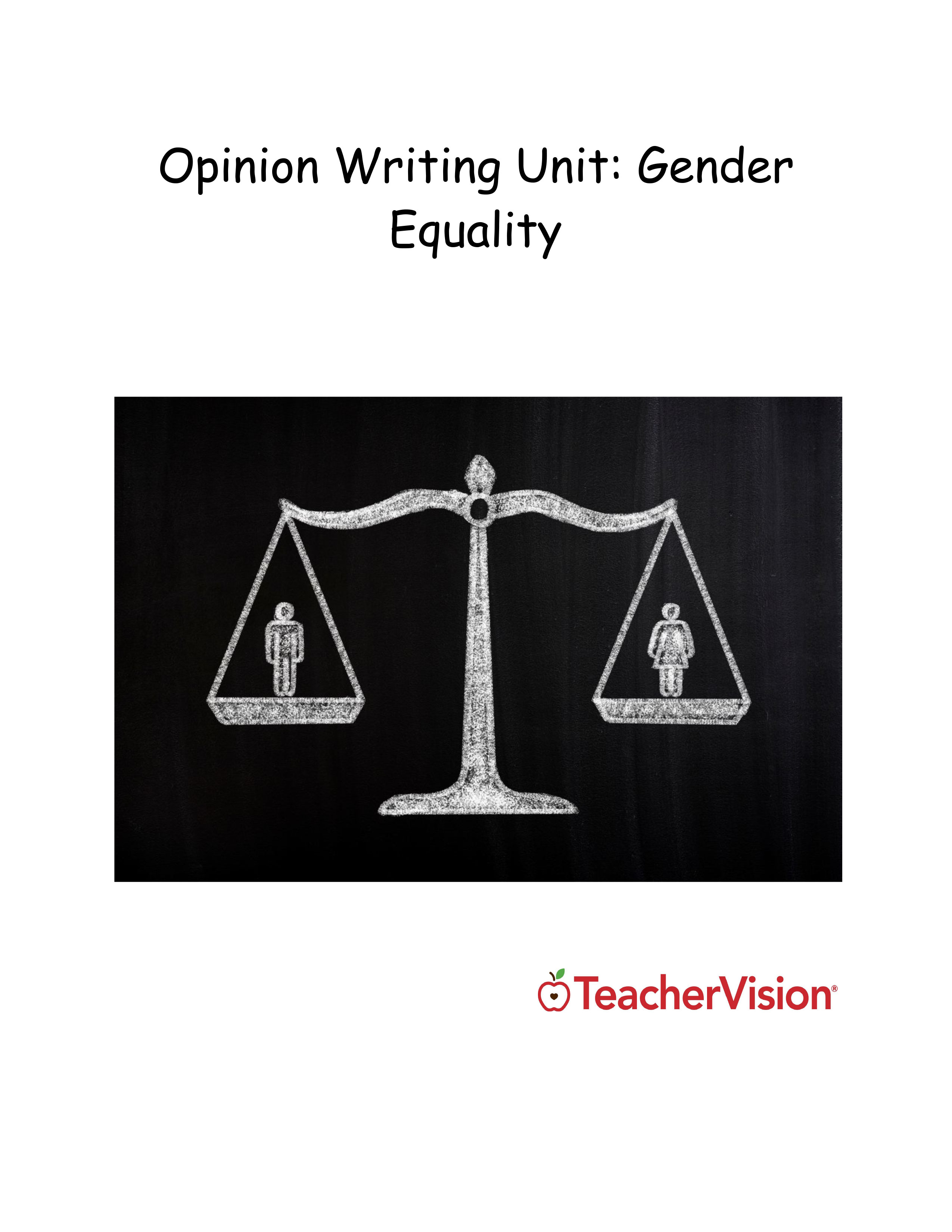

- Online Calculus Tutors
- Online Geometry Tutors
- Online Algebra Tutors
- Online Trigonometry Tutors
- Online Statistics Tutors
- Online Chemistry Tutors
- Online Macroeconomics Tutors
- Online English Tutors
- Online Physics Tutors
- Online Computer Science Tutors
- Online Accounting Tutors
- Online Biology Tutors
- Online Business Studies Tutors
- Online Finance Tutors
- Online Programming Tutors
- Online Management Tutors
- Online Science Tutors
- Year 2 Maths
- Year 3 Maths
- Year 4 Maths
- Year 5 Maths
- Year 6 Maths
- Year 2 English
- Year 3 English
- Year 4 English
- Year 5 English
- Year 6 English
- Year 7 Maths
- Year 8 Maths
- Year 9 Maths
- Year 10 Maths
- Year 10 Advance Maths
- Year 7 English
- Year 8 English
- Year 9 English
- Year 10 English
- Year 11 General Maths
- Year 11 Chemistry SA,NT
- Year 11 General Mathematics VIC
- Year 11 Mathematical Methods
- Year 11 Mathematics Standard
- Year 11 Chemistry ACT
- Year 11 Mathematics Extension 1
- Year 11 Mathematical Methods SA, NT
- Year 11 Mathematical Methods VIC
- Year 11 Mathematical Applications
- Year 11 Chemistry QLD
- Year 11 Literature ATAR
- Year 11 English - QLD
- Year 11 English Advanced NSW
- Year 11 EALD Level 3
- Year 11 English Language
- Year 11 Essential English M
- Year 11 Essential Skills TAS
- Year 11 Essential English
- Year 11 Bridging EAL
- Year 11 EALD Level 1
- Year 11 Stage 1 Essential English
- Year 11 English General
- Year 11 Mathematics Advanced
- Year 11 EAL
- Year 11 English Standard
- Year 11 EALD ATAR
- Year 12 Mathematics Standard
- Year 12 Further Mathematics
- Year 12 Mathematics Applications
- Year 12 Mathematics Extension 1
- Year 12 Mathematics Methods
- Year 12 Mathematics Advanced
- Year 12 Mathematics Methods VIC
- Year 12 Mathematics Methods - TAS
- Year 12 General Mathematics TAS
- Year 11 English T
- Year 12 Mathematical Methods - QLD
- Year 12 General Mathematics SA, NT
- Year 11 Foundation English
- Year 11 English Studies
- Year 11 Literacy Short Course
- Year 11 English Preliminary
- Year 12 English ATAR
- Year 11 EAL/D
- Year 12 English Extension 2
- Year 12 EAL/D
- Year 12 EALD ATAR WA
- Year 12 English Foundation
- Year 12 English Extension 1
- Year 12 Literature
- Year 12 Stage 2 Essential English
- Year 12 English Literature ATAR
- Year 12 Stage 2 English
- Year 12 EALD Level 2 - TAS
- Year 12 English Advanced NSW
- Year 12 Chemistry VIC
- Year 12 English Language
- Year 12 English Literature T - ACT
- Year 12 English Foundation WA
- Year 12 English Standard NSW Learning Programs
- Year 11 Chemistry WA
- Year 11 Chemistry - VIC
- Year 12 Chemistry - QLD
- Year 12 Chemistry - TAS
- Year 12 Chemistry - WA
- Year 12 Chemistry - NSW
- Year 12 Chemistry - ACT
- Online Tutors in Sydney
- Online Tutors in Melbourne
- Online Tutors in Brisbane
- Online Tutors in Gold Coast
- Online Tutors in Perth
- Online Tutors in Canberra
- Online Tutors in Adelaide
- Online Tutors in Newcastle
- HSC Papers 2019
- HSC Papers 2018
- HSC Papers 2017
Book a Free Demo
Math Calculus Geometry Algebra Trigonometry Statistics Chemistry Economics Macroeconomics English Physics Computer Science Accounting Biology Business Studies Finance Programming Management Science Year 3 Year 4 Year 5 Year 6 Year 7 Year 8 Year 9 Year 10 Year 11 Year 12 College
Search Here
Recent posts.
- General Achievement Test Australia
- ESL vs English Tutoring – What Makes Them Different?
- Know the Grading System in Australia
- GED vs HiSET: All You Need To Know
- HSPT vs PSAT: Which One Is Beneficial For You?
- WordPress.org
- Documentation
- Support Forums

65 Engaging 8th Grade Writing Prompts for Creative Essays
Creative writing is a discovery process, and 8th grade is a great time to encourage your students to find their voices. It’s the final grade before high school, and it’s a time when students are really discovering themselves and their place in the world as they leave middle school.
That’s why…
It’s so important to give your 8th-grade students writing prompts that will help them explore their thoughts and opinions. These 8th-grade writing prompts for creative essays are designed to do just that.
Journal Writing Prompts

Journaling is a great way to get your students’ creative juices flowing. It’s also a great way to get them thinking about their own thoughts and experiences. Here are some journal prompts to get your eighth graders started:
1. If you had the chance to travel anywhere in the world, where would you choose? What attracted you to that location?
2. Do people require a compelling reason to live? How would you characterize the purpose’s evolution over time?
3. Imagine you could go back in time and give someone advice. What would you say?
4. When it comes to writing, how do you feel? Consider something else in your life when comparing your feelings about writing to it.
5. Create a typical day in the life of an eighth-grader with a short story.
6. Write about your favorite movie or book. Why do you love it so much?
7. What do you like about your appearance?
8. Consider what you value in life and how it relates to where you want to be in five years. Make a personal vision statement for your life.
9. What are your thoughts on the notion of vulnerability? Have you ever been anxious when you’ve felt weak or exposed?
10. What are your biggest regrets so far in life? Why do you feel the way you do about it now?
11. Choose someone older, such as a grandparent. What is the most significant lesson you’ve learned from that individual?
Creative Writing Prompts
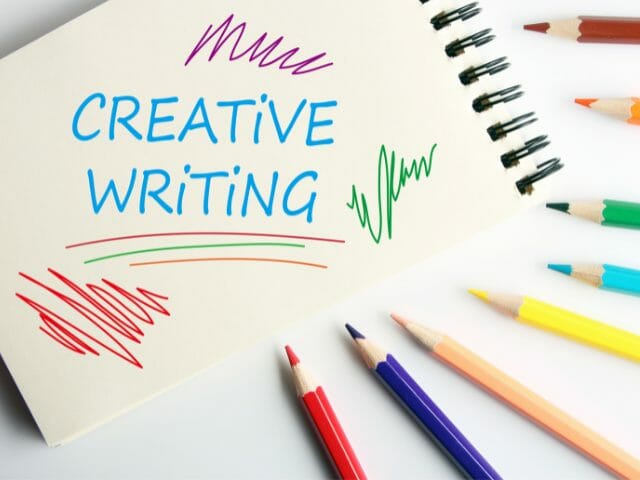
Creative writing is all about expressing yourself in your own unique way. That’s why it’s such a great activity for eighth-grade students. By allowing young writers to flex their creative muscles, they’ll be able to explore their thoughts in a way they might not have before.
Here are some creative writing prompts to get your 8th graders started:
12. If you had one opportunity to make a difference in the world, what would it be and why?
13. What would you change if you were in charge of your school and why?
14. If you had the power to transform your city’s appearance or structure, what would you do and why?
15. Who would you invite for dinner if you could choose any famous person?
16. Write a short story about what your life would be like if you lived in the cold deserts of Mongolia.
17. Your instructor has requested that you present a lesson with the fifth-graders. What will you speak about and why?
18. Name one thing you’d want to accomplish in the future. Describe why it is so essential for you and how you intend to achieve it.
19. “Don’t judge a book by its cover.” Have you ever heard that? What’s your take on it? To support your standpoint, utilize precise details and scenarios.
20. The town officials want you to create a community for the future. Share your vision using specific information and examples.
21. What would your brain be like if it were a physical location?
22. Write a scenario in which a usual family activity goes horribly wrong.
Expository Writing Prompts

Although similar to creative writing, expository writing is a different animal altogether. Here are some exciting prompts to get your middle-schoolers started:
23. What’s the most unusual location you’ve ever visited? Describe it in detail.
24. Tell us about your last birthday, from the moment you awoke until you went to bed that night.
25. Imagine your dream home. Make a list of each room and its features.
26. How do you get to your grandparents’ house or another family member home?
27. Write about your typical school lunch and your experience eating in the lunchroom.
28. Consider a career you’d like to have one day. Describe a typical working day in that position.
29. What unique characteristics do you possess as a member of this generation? How are people your parents’ or grandparents’ age different from yours?
30. What are three fun ways your family might spend a family vacation together?
31. Why do you think someone you know should be regarded as a leader?
32. Who’s your favorite teacher, and why?
33. If you had to be an animal, which one would you choose and why?
Precise Language Writing Prompts

When it comes to writing skills, precision is key. Your students need to communicate their thoughts and feelings clearly and concisely. That means they need to have a vast vocabulary and use it effectively. Here are writing prompts to help your students hone their skills:
34. Write a news article about a recent natural disaster.
35. Think about a time when you were extremely proud of yourself. Write a first-person account of your proudest moment.
36. What is your earliest memory of feeling fear? Write a brief story about that experience.
37. Are all teachers educators? Are all educators teachers? What is the difference between a teacher and an educator?
38. When should you say a specific number instead of “a lot” to avoid being mistaken?
39. What exactly makes something “made from natural components” distinct from anything grown in your backyard?
40. What is the difference between race and nationality?
41. What is the difference between music and sound?
42. What is the primary difference between being wise and being intelligent?
43. How can you tell the difference between an opinion and a fact?
44. Is it correct to refer to an 8th grader as a “young person”? Why or why not?
Counter-Argument Writing Prompts

To become better writers, students of this age group need to be able to anticipate and refute counter-arguments to their own claims. Here are some counter-argument writing prompts to get your reluctant writers thinking:
45. An old saying goes, “Early to bed, early to rise, makes a man healthy, wealthy, and wise.” Explain why this might not be true.
46. Some individuals believe that crying is a sign of weakness. Disabuse them of this misconception.
47. Some schools enforce a dress code to discourage bullying and encourage learning. Explain why you disagree with forcing students to wear uniforms.
48. Paranormal investigators sometimes utilize photographs as “evidence” that ghosts exist. Explain why a photo of a ghost might not be considered evidence.
49. Cats are widely regarded as the greatest pets. Why might dogs be a better choice?
50. Some people think that nothing is more essential than fame or popularity. Why do you feel differently?
51. Some people believe that smartphones shouldn’t be allowed in school because they’re a distraction. In favor of allowing phone usage in class, create an argument.
52. Some people believe that there should be no restrictions placed on freedom of speech. Defend your position by explaining why freedom of speech should be limited on occasion.
53. People sometimes believe that important core principles, such as religion and politics, must be shared by good friends. Explain why this isn’t necessary.
54. Some people believe that honesty is more important than compassion. Explain why kindness is more essential at times in your essay.
55. Many individuals think it’s better to be single than in a relationship. Why might being in a relationship be preferable?
Informational Writing Prompts

Informational writing is a key skill for students to master. After all, in the real world, we need to communicate clearly, whether we’re writing an email to our boss or a letter to our elected officials. Here are informational writing prompts to keep your students busy:
56. Ask your teacher to share some insights about their life. Then, create a one-page biography based on what you learned.
57. What do you know how to do well? Write detailed instructions for someone else to perform this task.
58. Consider a destination that you’ve been to. Describe the site to someone who has never been there before.
59. There are several different family structures. What kind of family do you have?
60. Choose a subject you’re well-versed in, like a favorite sports team, movie star, musical genre, or anything that fascinates you. Explain the topic to someone else in three pages.
61. What impact has new technology had on your life?
62. Is there a familial custom that is unique to your family? Describe the custom and why your family participates in it.
63. Tell us about a typical day in one of your parents’ lives.
64. What would you do if you won the lottery?
65. How do people in your community show their support for local businesses?
Jump In : Writing essays encourage G8 students to get more creative in writing and critical in thinking. Provide them with more enthusiasm by giving them 11 Fun 8th Grade Reading Comprehension Activities & Games to stimulate their minds!
Fun Fact : There are aids available to assist your students to create correct sentences (free and paid). I researched a particular tool that I believe will improve your learners’ writing skills. Learn more about it here — Complex Sentence Generator: 7 Tools To Build Good Statements .
Get Your Middle School Students Hooked on Writing With These Engaging Prompts!
8th grade is an important time for students to focus on their writing skills. As they prepare to transition to high school and beyond, they must develop a strong foundation now.
By offering them a variety of engaging writing prompts, you can help your students build confidence and proficiency in their writing. So get those pencils and pens ready, and let’s get started!
Last Updated on July 25, 2022 by Emily
- Pinterest 67
Emily is an active mother of two and a dedicated elementary school teacher. She believes the latest technology has made a huge impact on the quality of early learning and has worked hard to upgrade her classroom and her own children’s learning experience through technology.
Follow her on Twitter , Pinterest , and Instagram for more teaching fun!
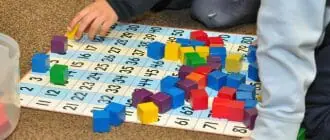
Save my name, email, and website in this browser for the next time I comment.

- Subscribe |
- Newsletter Index |
- Daily Dose |
- Site Map
- Home |
- SAT/ACT |
- Common Core |
- Online Practice |
- Printables |
- Grade Level Help |
- Links PreK-12 |
- Tech |
- Assessment
8th Grade - Conclusion
advertisement
Provide an effective conclusion that reinforces the focus of the presentation. 0801.2.15 Links verified on 7/15/2014 5 Effective Strategies to Conclude a Speech - Speech conclusion tutorial including strategies and speech topics for an effective way to conclude your public speaking speech Effective conclusions are critical to an effective presentation - ideas for concluding a speech [This expired page is from the Internet Archive known as the Wayback Machine .] Effective Conclusions - article with ideas for concluding a speech Plan Your Conclusion - four major components to a good conclusion Strategies for Writing a Conclusion - suggestions and examples Topic Sentences and Concluding Sentences - four questions, each requiring essay answers - consider printing this and using it as part of a lesson Trailblazing Conclusions ( 6 - 8 ) develop a sense of ending by using closure and thought-provoking statements Writing a Conclusion - tips and examples site for teachers | PowerPoint show | Acrobat document | Word document | whiteboard resource | sound | video format | interactive lesson | a quiz | lesson plan | to print
Search Internet4Classrooms
Internet4classrooms is a collaborative effort by Susan Brooks and Bill Byles.
- Technology Skills |
- Site Map |
- About Us |
- Teacher Training |
- Make Internet4Classrooms.com your home page. |
- Copyright © 2000-2024 Internet4Classrooms, LLC All rights reserved.
Use of this Web site constitutes acceptance of our Terms of Service and Privacy Policy .
Is Cornell University a Good Choice? What is Known For?
Should you study music at college is a music degree worth it, why is college so boring and depressing top 10 reasons, what are common mistakes made by college students, how important is college life in your career building, how can i be a successful graduate student 9 tips, how much do professors make 2023 guide, what makes college life challenging 7 challenges you’ll face in college, is 26 too old to enjoy college life tips for starting college at 26.

How Long is An Essay in 8th Grade? Writing Tips
Learn how long an essay should be in eighth grade and how to write a great essay by reading this article.
How long should an essay be in eighth grade? The format and the particular type of writing have a small impact on the length of the eighth-grade essay. However, the 8th-grade essay length varies from approximately 500 to 800 words. You must express yourself clearly and make all necessary points within this framework.
To help you write an essay in the eighth grade, we’ve prepared this list of imaginative topics, examples, and writing advice.
Table of Contents
How Long is An Essay in 8th Grade?
An essay for an eighth grade should be between 500 and 800 words long. In the eighth-grade essay, each paragraph must contain a minimum of 8 sentences. Additionally, keep in mind that the sentences are mostly complex or compound, flawless, and coherent. Also, keep in mind to use specific language to connect the sentences and paragraphs. Learn How Long is An Essay in 6th and 7th Grade.
To write an excellent 8th-grade essay, you should:
- Select a worthwhile subject, then decide how you will approach the issue.
- Create an outline.
- Formulate a succinct and clear thesis statement.
- If the essay type requires it, come up with at least three solid arguments.
- Impress your audience with a solid conclusion. Remember to proofread!
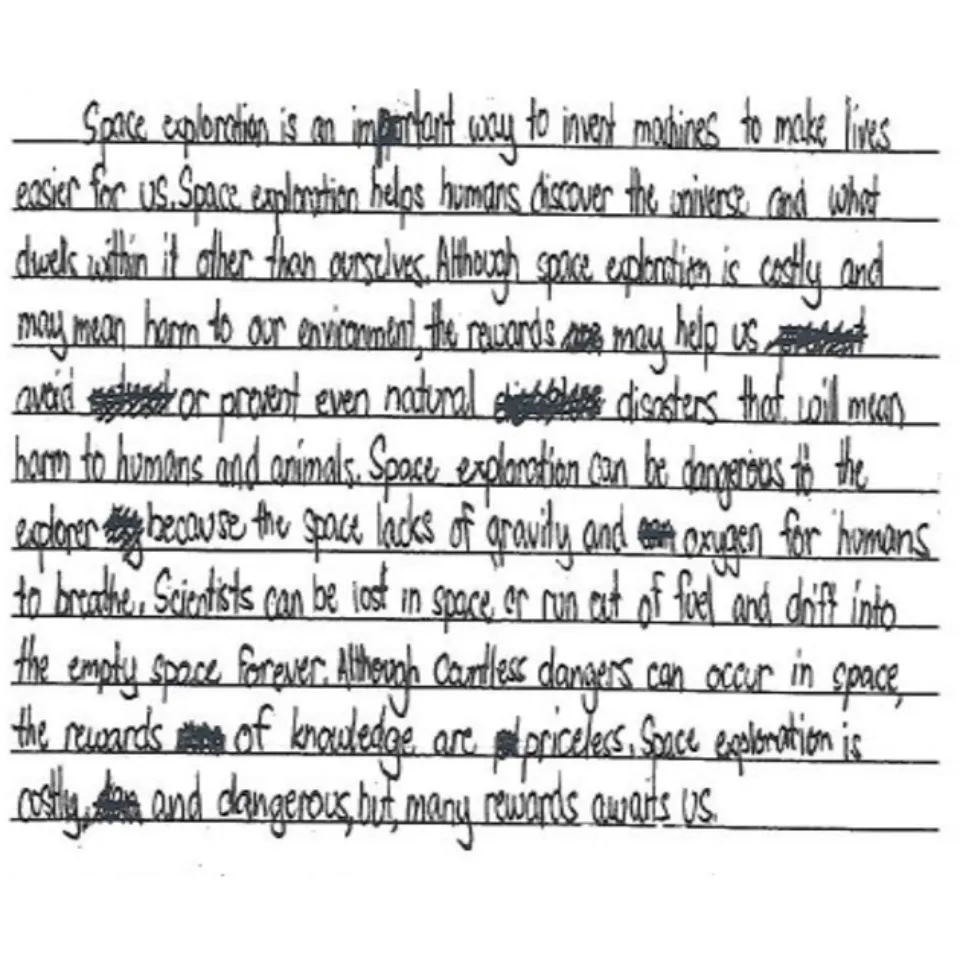
What is the 8th-Grade Essay Format?
You’ll learn what goes into an essay for the eighth grade in this section. You’ve entered a completely new level, which is the first thing to keep in mind. Therefore, your writing is longer and more complex than it was during your earlier academic years.
Beginning with the structure The fundamental parts are the same as in any type of essay:
- Introduction: An intro should contain something intriguing to catch your audience’s attention. It’s typically a hook or an opening sentence that piques readers’ interest in your essay. The next significant part of your introduction is the thesis statement . The reader learns about the topic of your essay from your paper’s central idea.
- Body paragraphs: Body paragraphs contain supportive arguments and evidence. They need to be reliable and convincing.
- Conclusion: After everything is written, you are to conclude the ideas you’ve delivered.
How to Write An Excellent Essay?
You can learn the easiest and most practical advice for writing an essay for the eighth grade in this section. Anyone in the eighth grade should be aware of these things.
- To find justifications and supporting information, look for trustworthy sources.
- Try to incite enthusiasm for writing; it will undoubtedly make the process easier for you.
- If you have a choice, pick the subject that most interests you.
- Use formal language, appropriate grammar, specific terms, and consistent phrases.
- Make your points more compelling by referencing credible quotations.

Don’ts
- Write clearly; an essay is a story. It ought to be exciting and reliable.
- Don’t make all your examples too similar: diversity is of the essence.
- Use graphic tools to emphasize the most important points in your text to avoid having it appear like an unreadable mess of words.
- Use only trustworthy sources and websites when citing information.
- Do not be afraid to express yourself honestly. Your eighth-grade essay is distinctive because of who you are and what you think.
- Don’t forget to edit your text once you’ve finished writing it.
Eighth Grade Essay Types
During middle school, we assume that you encounter various kinds of assignments. There were indeed descriptive and narrative essays among them. However, now you are to face other exciting formats of writing. Get to know a few new types in the section below.
Informative and Explanatory Writing
In their informative and explanatory papers , students use formal language to explain complex topics with relevant data, precise ideas, and logical analyses. A captivating introduction that gives a sneak peek at the subject matter should be the first step for children. They then present information that is well-organized and supported by data from reliable sources. Eighth graders should use a variety of “strategy tools,” including:
- information classification.
- Defining terms.
- utilizing transitional, academic, and subject-specific vocabulary words.
- Quoting sources.
- Factual information is included.
- Making comparisons.
- comparison of various circumstances.
- describing the causes and effects of relationships.
- including multimedia and graphics (charts, tables, and pictures).
- Using headings and bullet points for formatting.
The final paragraph should provide a summary of the essay’s main idea. Your child’s papers are likely to cover topics that students are familiar with — but still need to research in order to answer, like What are some ways we can conserve water in a drought? Or Explain how a specific invention has changed your life .
Narrative Writing
Eighth graders write narratives or stories that describe events in their lives (personal histories, memoirs) or imagined scenarios (fiction, fantasy). Effective storytelling strategies are taught to junior J.K. Rowlings, including how to introduce the narrator and characters, set the scene, and convey a point of view.
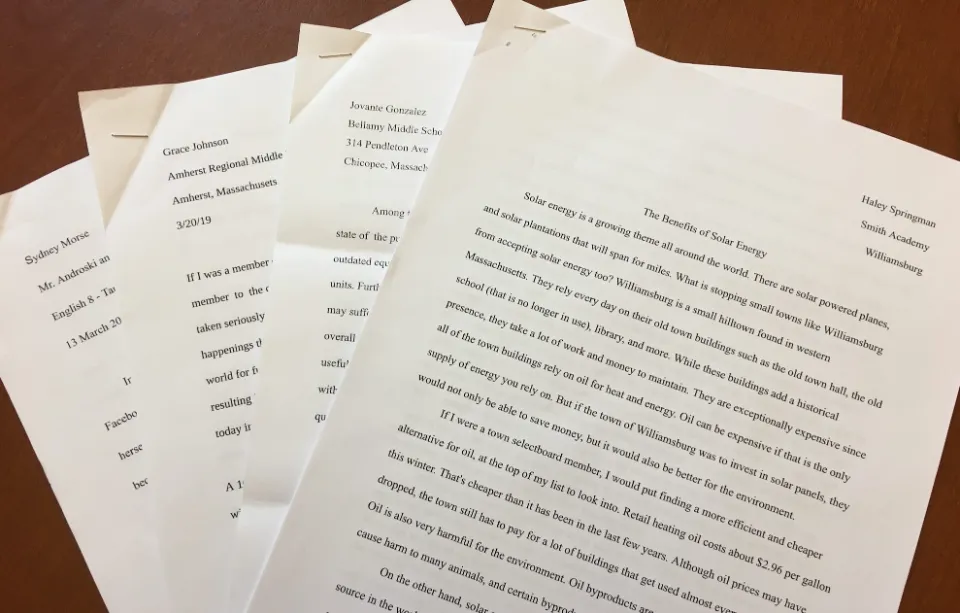
Students work on letting the events flow naturally, developing the characters’ personalities, and creating a compelling plot through the characters’ deeds, words, and thoughts.
Argumentative Essay
An argumentative essay is a piece of writing in which you present a claim and support it with convincing evidence. At this point, your goal is to persuade readers to agree with your viewpoint while they read.
You should provide specific data in your argumentative essay to support your position, such as statistics, figures, research studies, and polls.
Persuasive Essay
Similar to writing an argumentative essay, a persuasive essay is persuasive. There, you must choose a topic that is particularly pressing and form a strong opinion on it. Making your audience believe you are the main objective, just like in an argumentative essay.
Remember the three essentials of persuasive writing:
- It is clear that Logos appeals to logic. Clearly and logically communicate your ideas.
- By appealing to the reader’s sense of morality and ethics, ethos aims to persuade them.
- Pathos aids in emotional persuasion.
Conclusion: How Long is An Essay in 8th Grade?
In eighth grade, how long should an essay be ? 500 to 800 words are enough. You should write an introduction, body paragraphs, and a conclusion. The number of paragraphs should never be less than 8 sentences in one.
The Length of Each Part in an Essay
The Length of Different Kinds of Essays
The Length of Essays in Different Grades
Leave a Reply Cancel reply
Your email address will not be published. Required fields are marked *
Save my name, email, and website in this browser for the next time I comment.

Related Posts
How can teachers help students be successful 10 strategies, how to get students to stop talking 9 effective strategies, how long is an argumentative essay how to write a good argumentative essay, how long is the introduction of an essay perfect introduction length, 6 effective tips on how to maximize instructional time in the classroom, 13 reasons why should students get paid for good grades.

IMAGES
VIDEO
COMMENTS
⚪: Introduction : An intro should contain something intriguing to catch your audience's attention. It's usually a hook: a starting point that makes your readers keep reading your essay. The next significant part of your introduction is the thesis statement. It's the leading thought of your paper that reveals to the reader the essay's subject matter.
Step 1: Return to your thesis. To begin your conclusion, signal that the essay is coming to an end by returning to your overall argument. Don't just repeat your thesis statement —instead, try to rephrase your argument in a way that shows how it has been developed since the introduction. Example: Returning to the thesis.
When wondering how to write a conclusion, it boils down to this: Conclusions should round off the topic and leave a strong impression in the readers' minds. ... For the most part, if you know how to write a conclusion for an essay, you know how to write conclusions period. You won't find too much variation between an essay and other papers ...
Restate Main Points. Another key aspects of how to write a conclusion paragraph is that you signal that you are drawing your essay to a close, so that you can then restate the main points of your essay. Depending on the length of your essay, this may be done in a single sentence, or it may require a few sentences.
Restate the main idea of your essay. A good conclusion should summarize the main points of your essay and reiterate the main idea or thesis statement. Provide closure to your argument. Your conclusion should provide a sense of closure to your argument and tie up any loose ends. Emphasize the importance of your topic.
Writing a Conclusion Paragraph. 1: Restate your Thesis! - Start your paragraph by restating the thesis statement you made in your introduction. Either reword it or keep it the same. 2: Summarize your main ideas (subtopics) - Summarize your 3 subtopics, writing one sentence for each subtopic you have. 3: Wrap up your paper! - Find a way to ...
Careful though, generally, "List Statements" don't work well as a conclusion sentence. 4. Make an Opinion Statement. One idea that has really helped my students write conclusions is to have them practice writing the conclusion as an opinion statement. So, if the paragraph is about taking care of a dog, the conclusion could be an opinion ...
Use the Grade 8 Writing Process checklist to assess students' writing abilities in Work Time A and B (located on the Tools Page). Down the Road. In the next lessons, students will use their plans created in Lessons 3 and 4 to draft and revise their essays. ... If students are ready to begin planning the conclusion of their essay independently ...
These three key elements make up a perfect essay conclusion. Now, to give you an even better idea of how to create a perfect conclusion, let us give you a sample conclusion paragraph outline with examples from an argumentative essay on the topic of "Every Child Should Own a Pet: Sentence 1: Starter.
W.8.4 - Work Time B: Students work in pairs to produce clear and coherent writing as they develop the conclusion of their practice essay. W.8.5 - Work Time B: Student partners provide support to each other as they draft the conclusion to their practice essay. W.8.5 - Closing and Assessment A: Students receive and provide feedback to ...
Verbal has a double meaning for eighth grade writing: it refers to the oral presentations the kids will do and to this year's focus on grammar — gerunds, participles, and infinitives.. Argument essays. Written in formal language, argument essays should start with an introduction that clearly presents the writer's position and flows into a well-organized, research-backed argument that ...
length. A common essay length is approximately 500 words and requires at least three ways in which the subjects are alike or different. Your thesis should tell the reader exactly what you are going to compare or contrast. Persuasive Writing The purpose of persuasive writing is to assert an opinion which you are going to defend and to offer
But, I was now a seventh and eighth grade ELA teacher who could no longer hope her students picked up some writing skills along the way. So I did what any good teacher would do…. I Googled how to teach… I think I Googled something like, "Examples of middle school literary analysis essays." Nothing showed up in Google.
Success and Failure: Writing an Essay. In this activity, students will explore how they measure success and failure in themselves and in others. With direction…. Subjects: Language Arts and Writing. Writing. Essays.
This essay frame includes simple introduction and conclusion paragraphs, along with paragraphs to analyze characters and their growth, theme, and figurative language. By using this frame, students will have a structured essay th. Subjects: English Language Arts, Literature, Writing-Essays. Grades: 4 th - 10 th.
August 31, 2022. homeworkhelp. Students. A grade 8 school student have to write many essays on different topics. Thankfully we have put together a list of 25 great essay topics to ease your task.
Learn best practices on improving writing instruction and building students' writing confidence. In a survey of 3rd to 8th grade teachers, nearly half of the respondents indicated that they don't enjoy teaching writing. That's due in part to the lack of instruction provided by teacher prep programs on exactly how to teach writing. While there are multiple courses dealing with helping ...
That means they need to have a vast vocabulary and use it effectively. Here are writing prompts to help your students hone their skills: 34. Write a news article about a recent natural disaster. 35. Think about a time when you were extremely proud of yourself. Write a first-person account of your proudest moment. 36.
Plan Your Conclusion - four major components to a good conclusion. Strategies for Writing a Conclusion - suggestions and examples. Topic Sentences and Concluding Sentences - four questions, each requiring essay answers - consider printing this and using it as part of a lesson. Trailblazing Conclusions ( 6 - 8) develop a sense of ending by using ...
ClassX's AI Essay Grader empowers teachers by automating the grading process without compromising on accuracy or fairness. The concept is elegantly simple: teachers input or copy the students' essays into the provided text box, select the appropriate grade level and subject, and ClassX's AI Essay Grader takes it from there.
This video is a quick guide to writing an introduction and conclusion for the "Flowers For Algernon" text-dependent analysis essay for 8th grade Language Art...
An essay for an eighth grade should be between 500 and 800 words long. In the eighth-grade essay, each paragraph must contain a minimum of 8 sentences. Additionally, keep in mind that the sentences are mostly complex or compound, flawless, and coherent. Also, keep in mind to use specific language to connect the sentences and paragraphs.
A new tool called Writable, which uses ChatGPT to help grade student writing assignments, is being offered widely to teachers in grades 3-12. Why it matters: Teachers have quietly used ChatGPT to grade papers since it first came out — but now schools are sanctioning and encouraging its use. Driving the news: Writable, which is billed as a ...